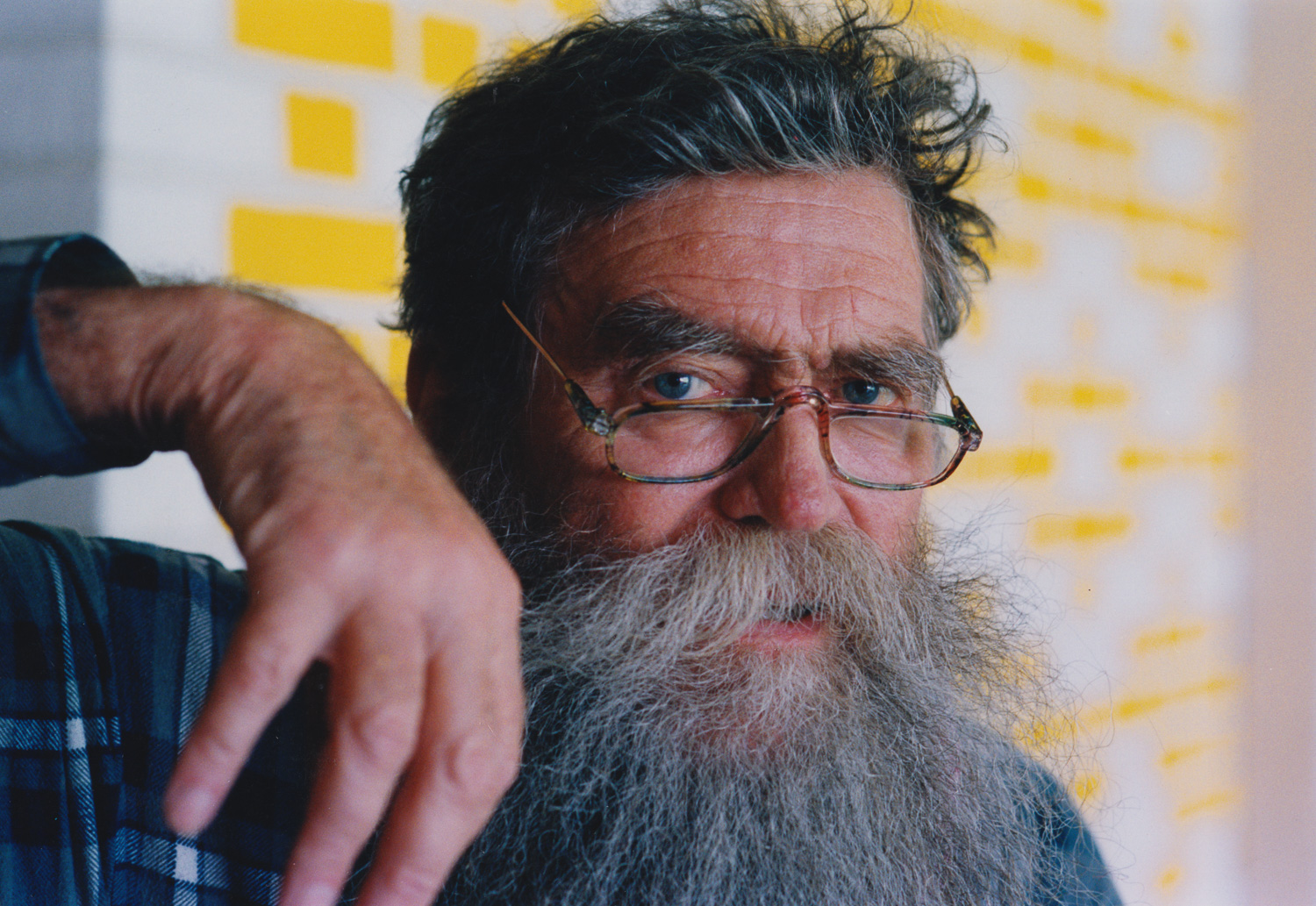
Poul Gernes 1992
Photo: Jens Astrup
Poul Gernes was a prominent figure in Danish art from the early 1960s until his death in 1996. His groundbreaking work as a visual artist can be divided into three phases:
• He was one of the initiators of the Experimental Art School (1961-69), whose alternative, collective art practices broke with the established art scene. At the school, Gernes served as a teacher, organizer, and active visual artist. He collaborated with Troels Andersen, John Davidsen, Per Kirkeby, Peter Louis-Jensen, Bjørn Nørgaard, and others.
• With his colour scheme for the newly constructed Herlev Hospital (1970-76), Gernes created a carefully considered, vibrant, and varied chromatic language for all the hospital’s functions, from the entrance hall and corridors to departments and patient wards.
• Together with his wife, Aase Seidler Gernes, his daughter Ulrikka Gernes, and a team of assistants, Poul Gernes carried out around 150 decorative works of diverse character across the country from 1977 until his death.
Poul Gernes held strong opinions about the role of art in society. He consistently expressed his views through articles, pamphlets, books, and public debates. As an exhibitor, teacher, and later professor at the Royal Danish Academy of Fine Arts in Copenhagen, he combined ideological perspectives with artistic practice, demonstrating that visual art, when serving the public, can convey uplift, insight, and beauty.
Childhood and youth
Poul Gernes was born on March 19, 1925, in Frederiksberg, as the son of shoe manufacturer Viggo Gerner Nielsen (?-1958) and Ellen née Finnerup (1900-1984). He started painting at an early age, inspired by his aunt Margrethe Clausen (1901-1985). She had trained at the Royal Danish Academy of Fine Arts, exhibited regularly at Charlottenborg’s Spring Exhibitions, and was active in a network of women artists. [note]Erik Steffensen: Poul Gernes – Monografi. Copenhagen 2000, p. 18.
In 1943, Poul Gernes became an apprentice lithographer at Andreasen & Lachmann, a prominent lithographic workshop best known for its high-quality advertising posters. He completed his training in 1948 with the assessment "praiseworthy.”
As an apprentice, he attended evening classes at Frederiksberg Technical School, where he met Aase Seidler Jensen (1927-2018), who was training as a textile printer. The two became a couple in 1946, married in 1948, and had four surviving children. The couple settled in Herlev in 1953 and later moved to southern Sweden in 1965.

Poul and Aase's wedding card, made by Poul Gernes, 1948
Photo: scan
As a young man, Poul Gernes painted and drew naturalistic subjects, including landscapes, gardens, and figures. His early works reveal inspiration from Danish naturalism. J. F. Willumsen, Henri Matisse, and Neo-Impressionism have also been identified as significant influences. [note]Troels Andersen: ”Paul Gernes.” In Sys Hartmann (red.): Weilbach – Dansk Kunstnerleksikon – Andet bind. Copenhagen 1994, p. 436-438.
In 1948-49, Poul Gernes moved away from naturalistic expression toward a purely nonfigurative style. In 1949, he made his debut at the Artists’ Autumn Exhibition with three compositions featuring linear motifs of intersecting horizontal and vertical lines.
In the following years, Gernes grew uncertain about painting and turned his attention to architecture and furniture design.
Aase and Poul Gernes’ first home was on Ravnsborggade in Nørrebro, Copenhagen, but in 1953 they built a single-family house in Herlev as self-builders (with the support of a government-guaranteed loan). The house included a workshop with a long printing table for Aase Gernes’ textile production. Her work, along with the financial support provided by the construction loan, became the family’s primary source of income during the 1950s and early 1960s. Their combined income was supplemented by both spouses’ teaching, particularly in evening schools. [note]Nina Hobolth: “From a corner of the world.” In Ulrikka S. Gernes, Nina Hobolth & Maj-Britt Willumsen (ed.): Aase Seidler Gernes. Frederiksberg 2015, p. 65.
The family grew with the birth of Jesper in 1951 and Anne-Sofie in 1954. Several years later, Konrad was born in 1962, followed by Ulrikka in 1965.
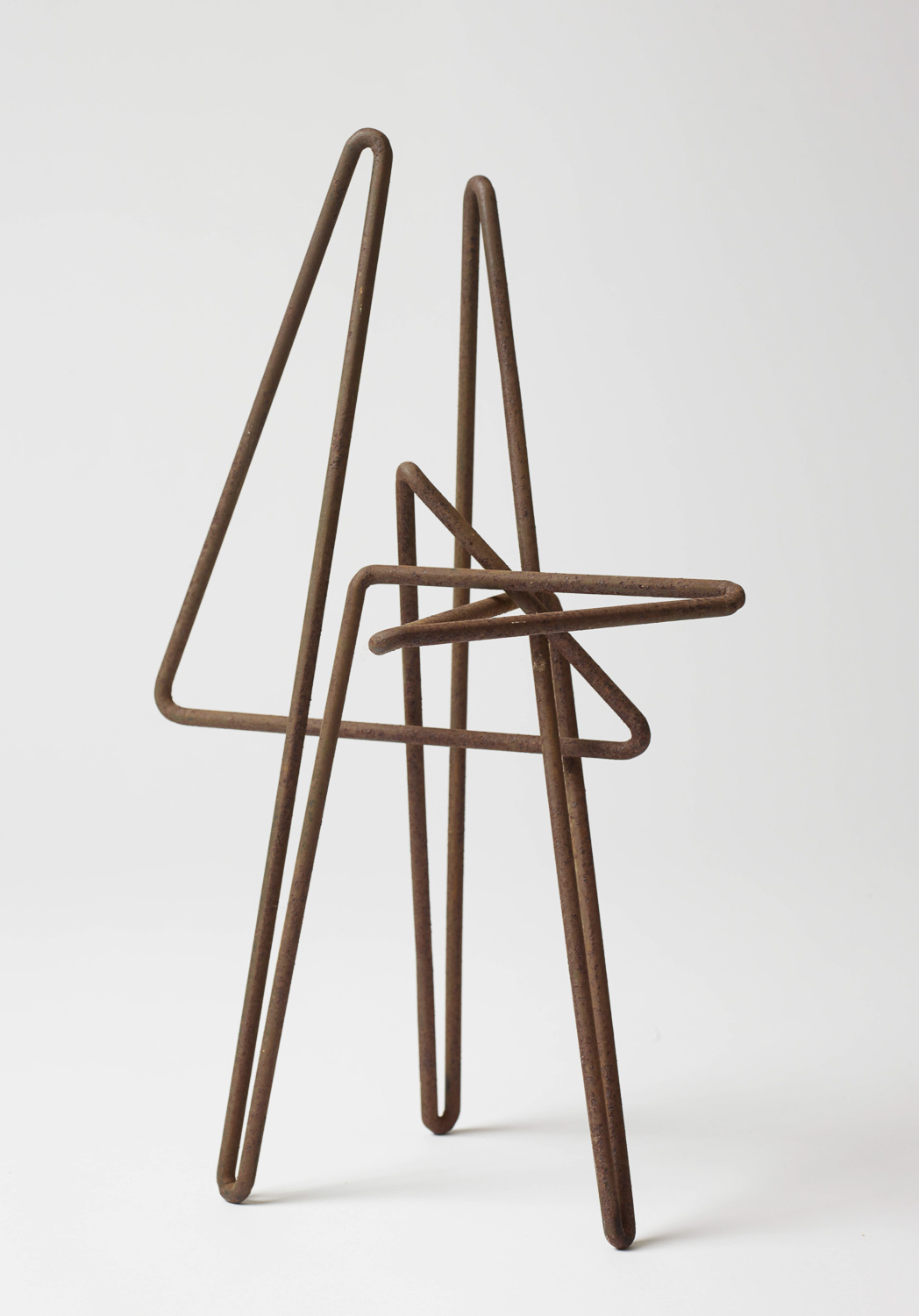
Model for sculpture at Atomic Research Station Risø, 1956
Photo: Anders Sune Berg
Early career
For Poul Gernes, the 1950s were restless, searching years. He was uncertain about his vocation, turned away from traditional visual art, and explored a more experimental artistic approach. His interests shifted to designing furniture, lamps, and wallpaper. He was briefly involved in one of the hotspots of Danish modernism when he worked as an assistant in the studio of artist and architect Gunnar Aagaard Andersen (1919–1982). Stylistically related to Gernes’ furniture design was also a proposal for a monument at Risø Atomic Research Station, which he submitted for a competition in 1956. [note]Troels Andersen: ”Poul Gernes.” In Dirk Luckow (ed.): Poul Gernes. Cologne 2010, p. 59-62. Translation of: ”Paul Gernes.” In: Eksempler og motiver – Artikler om dansk kunst i det 20. Copenhagen 1988; Troels Andersen: ”Gernes.” In Karola Grässlin (ed.): Poul Gernes. Kunstverein Braunschweig 2002, p. 28-9; Lars Morell: Broderskabet – Den eksperimenterende Kunstskole 1961-69. Copenhagen 2009, p.10.
On a more anecdotal note, Poul Gernes traveled to Norway in the summer of 1957 to participate as an extra in the Hollywood film The Vikings, directed by Richard Fleischer and starring Kirk Douglas and Janet Leigh. A historical fiction film required authentic-looking Vikings with blue eyes and full beards. Poul Gernes fit the bill – and got paid for it. [note]Erik Steffensen: Poul Gernes – Monografi. Copenhagen 2000, p.37.
In 1959-60, Poul Gernes returned to the abstract visual compositions he had worked on a decade earlier. He created a series of paintings, ink drawings, and prints that resembled labyrinths. They consisted of continuous horizontal and vertical lines, occasionally punctuated by small fields of colour within the black-and-white patterns and surfaces.
A selection of these works was exhibited in the spring of 1960 at Galerie Hybler, a leading venue in Copenhagen’s art scene. The exhibition garnered attention and marked Poul Gernes’ return to the world of art and exhibitions. It was here that he connected with the German Fluxus artist Arthur Köpcke (1928–1977), whose influence on the Danish art scene was profound.
Another important hub for the artistic breakthroughs of the 1960s was Galerie København, which opened in May 1961. Here, Poul Gernes exhibited paintings where “one could still follow the labyrinthine line as a nerve of emotion, but this time set against an ocean of vividly coloured, organically applied paint spots.” [note]Erik Steffensen: Poul Gernes – Monografi. Copenhagen 2000, p.44.
The gallery’s owner, Mogens Kjær, wanted to establish a Nordic academy for ballet, visual art, literature, music, and theatre. But when these ambitious plans stalled and the planning group made no progress, Poul Gernes, who had participated in numerous preparatory meetings, grew impatient. Ole Schwalbe, whom Gernes knew from his technical school days, encouraged him to begin by realizing the idea of a painting school. Gernes, who had met Troels Andersen during the NORDAK meetings, embraced the suggestion, thereby laying the foundation for an experimental art school. [note]Lars Morell: Broderskabet – Den eksperimenterende Kunstskole 1961-69. Copenhagen 2009, p. 26-7.
Poul Gernes was also one of the key figures behind the Summer Exhibition, which began as a counter-movement to traditional juried exhibitions such as the Artists’ Autumn Exhibition and Charlottenborg’s Spring Exhibition. The Summer Exhibition, first held in Den Frie Udstillingsbygning (the Free Exhibition Building) in 1961, became another milestone for new movements challenging the conventional art world.
A jury with a keen sense for contemporary art reviewed 1,700 works by 280 artists and selected 228 works by 65 artists for display. Among the exhibitors were artists who, in the following years, became prominent names in Danish art. Several joined the alternative art school envisioned by Poul Gernes and the NORDAK group, including Peter Louis-Jensen, Roger Martyn Pring, and Poul Gernes himself. [note]Lars Morell: Broderskabet – Den eksperimenterende Kunstskole 1961-69. Copenhagen 2009, p.22; Tania Ørum: De eksperimenterende tressere - Kunst i en opbrudstid. Copenhagen 2009, p.125.
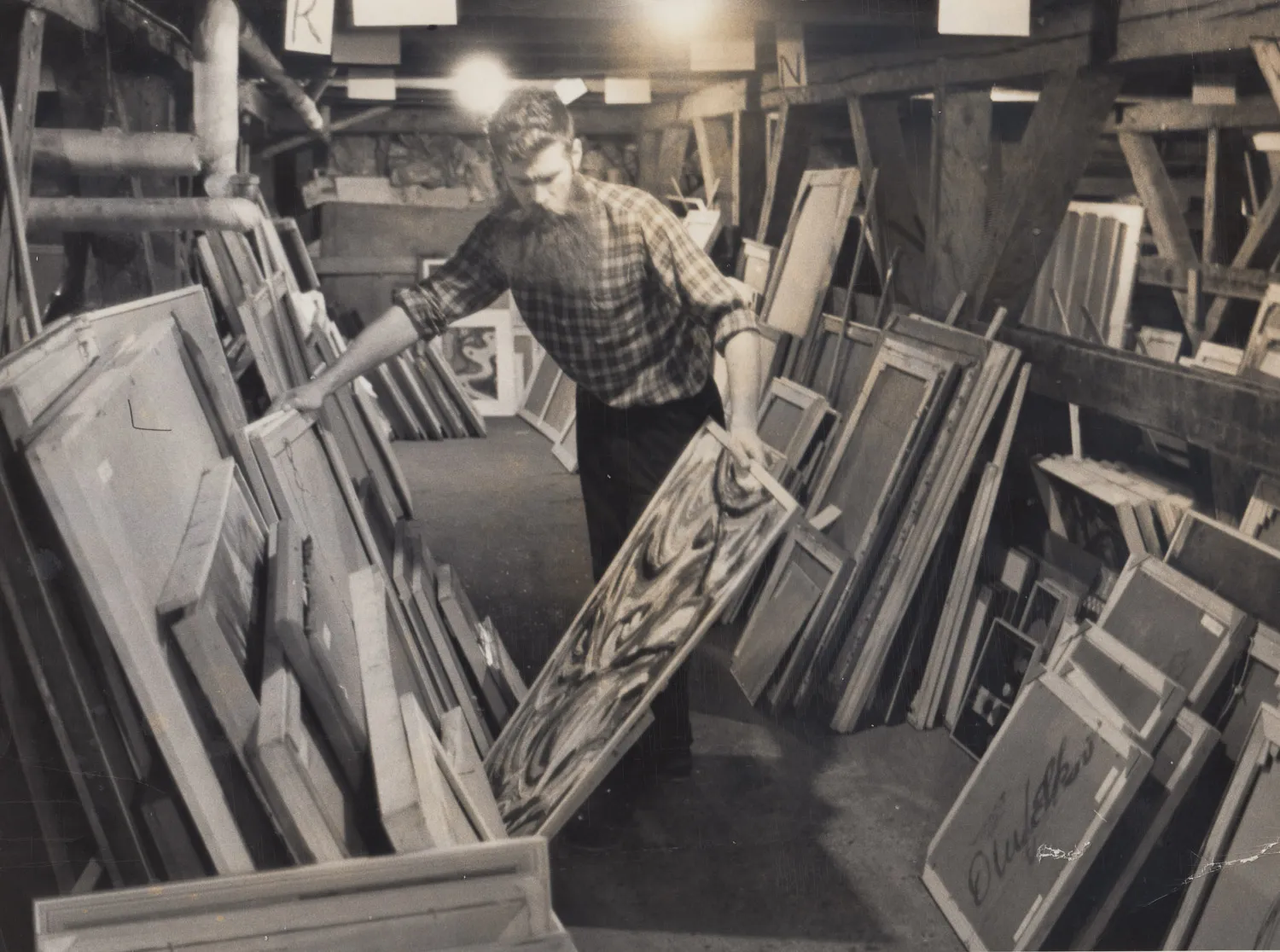
Poul Gernes preparing for Sommerudstillingen (the Summer Exhibition) at Den Frie Udstillingsbygning, 1961
Photo: Sven Gjørling
Establishment of the Experimental Art School
Poul Gernes and art historian Troels Andersen (1940-2021) developed the framework for the new school. It was intended to take an anti-academic approach, driven by an outward-looking and curious view of art. For this reason, it was named Den eksperimenterende Kunstskole (the Experimental Art School), abbreviated to Eks-skolen (The Ex-school). Its significance in Danish art history became truly groundbreaking.
The Ex-school was initially established without premises or funding, but within a short time, it secured a location and public grants to realize its vision. However, the school’s survival depended on unpaid teaching staff and an extremely modest budget. Student enrollment began in October 1961, with both day and evening classes. Early students included Peter Louis-Jensen, Erik Gram-Hansen, and John Davidsen.
As the name suggests, the experimental approach to art was central to the school. Traditional teaching methods were replaced with new initiatives. The student-teacher hierarchy was dissolved, and the school’s participants were united in a “brotherhood.” Artistic practices were anti-authoritarian, and collective working methods became the norm. [note]Tania Ørum: “The experimental art school.” In Alice Maude-Roxby & Joan Giroux (ed.): Anti-Academy. Southampton 2013, p. 93. Throughout the 1960s, Poul Gernes—by virtue of his commanding personality, his age (10–15 years older than most other members), his experience, and, not least, his relentless creativity—was a prominent figure at the Ex-school. The school’s methods centred on open dialogues. The physical results took the form of material studies, exhibitions, happenings, and performances.
Poul Gernes’ association with the Ex-school is divided in two periods. The first lasted from the school’s founding in the autumn of 1961 until 1964. In 1964, Poul Gernes and his family went on a year-long journey through Europe and North Africa. Upon returning, he resumed his involvement with the school and worked on exhibition projects alongside other artists from the Ex-school.
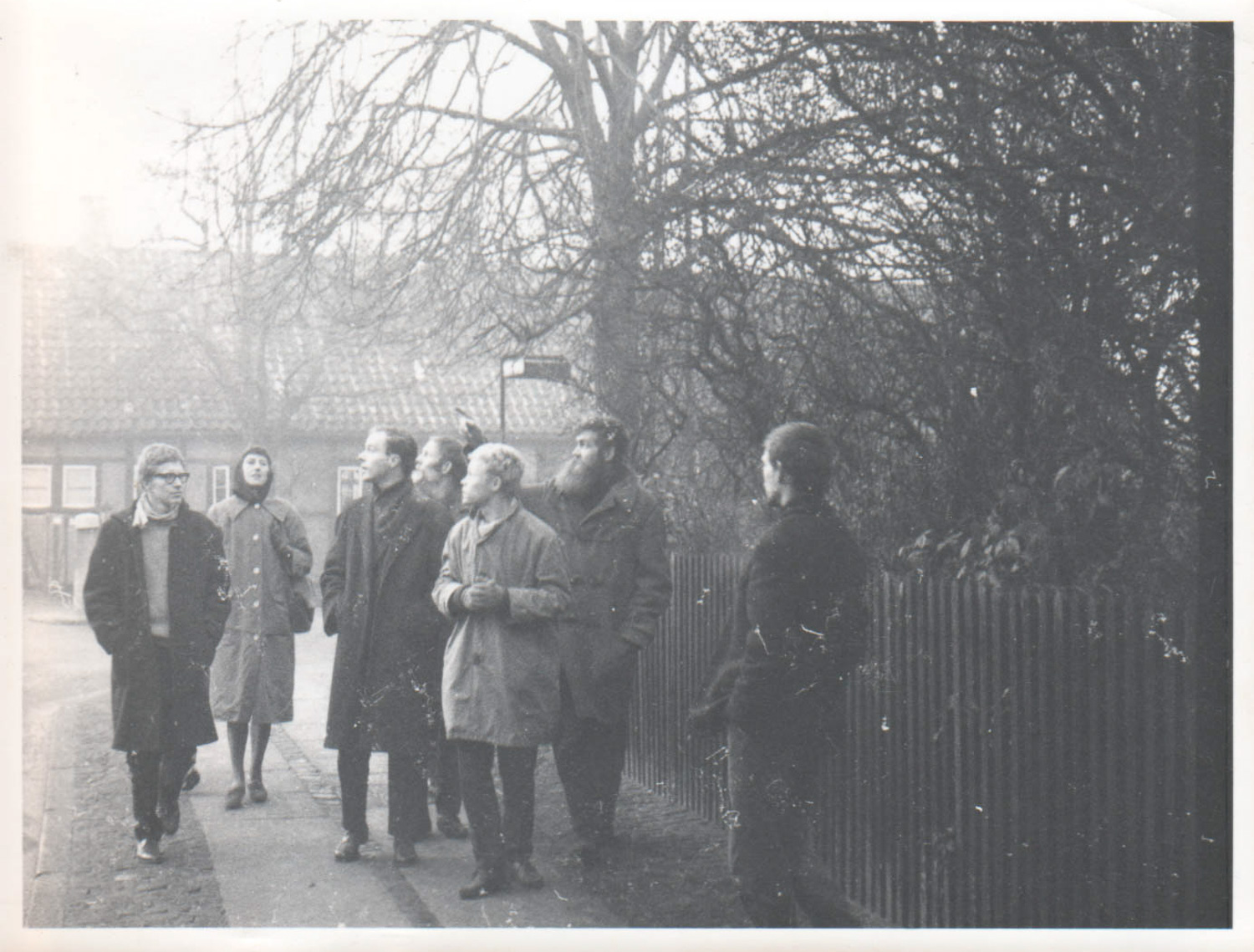
The Experimental Art School on an outing, 1961-2. From left to right: Bjørn Rønne, Kate Jönsson, Troels Andersen, Leif Holmberg, Peter Louis-Jensen, Poul Gernes and erik gram:hansen
Photo: unknown
The Experimental Art School 1961-64 – material studies
In the first years at the Ex-school, Poul Gernes created works departed radically from his earlier abstract pieces. Up to that point, his paintings and drawings had been characterized by hand-held brushwork and were closely related to the constructivist painting style, which dominated Danish art at the time, with Richard Mortensen and Robert Jacobsen being its most prominent figures. Now, the activities at the Ex-school brought a new and wide-ranging diversity to his artistic work.
The school’s pedagogy was largely driven by Poul Gernes, who sought to create a collaborative workspace and studio environment. Activities included lectures, gallery visits, and weekly excursions to nearby junkyards, where the collected trash was transformed into sculptures and collages.
During the early days of the school, guest instructors were invited to introduce various techniques, with graphic processes becoming a central area of focus. Jørgen Rømer and Richard Winther taught techniques such as drypoint and etching. Poul Gernes, who as a lithographer had a strong command of graphic techniques, created prints that almost defied imagination. Large zinc plates were perforated with a hammer – In the work Over 100 slag med en hammer (Over 100 blows with a hammer) – or placed under buses to capture tire impressions – Aftryk af dæk på buslinje 29 (Tire tracks from bus line 29) . Wire sculptures and metal reliefs with folds and perforations were three-dimensional parallels to the graphic prints, and Gernes’ paintings from the same period, with splashes of colour, can be seen as counterparts to the hammer strikes. [note]Lars Morell: Broderskabet – Den eksperimenterende Kunstskole 1961-69. Copenhagen 2009, p.33-56.
The early days of the Ex-school in 1961 were dominated by material studies led by Poul Gernes. Using items from scrap dealers and junkyards—such as old doors, toilet seats, metal scraps, cans, and radio components—students and teachers created sculptures and collages. Paint was scavenged from factories, stores, and dumpsters. Unlike traditional academic practices, where students practiced drawing and graphic art in closed studios for years, the members ventured outside its classrooms after just a few months, making the school visible through student exhibitions, public demonstrations, and participation in competitions.
The first student exhibition was held in April 1962, (and, in principle, there was no distinction between students and teachers, as everyone exhibited on equal terms) in the basement gallery at Admiralgade 20. The exhibition featured 27 participants, including John Davidsen, Egon Fischer, Poul Gernes, Per Kirkeby, Peter Louis-Jensen, Jørgen Rømer, and Richard Winther.
In May 1962, the second Summer Exhibition was held at Den Frie (the Free Exhibition Building). The catalogue was edited by Poul Gernes. Many graphic contributions to the catalogue came from the Experimental Art School, and the artists were well represented in the exhibition.
At the start of the new school year in September 1962, the school attempted to gain visibility through a public demonstration by moving the graphic workshop to Kongens Nytorv. Graphic works were created, collective paintings were made, and balloons were launched, carrying gift certificates for a graphic artwork.
Storkøbenhavns Mejerier (Greater Copenhagen Dairies Association) invited nine artists to propose designs for a milk mural. Poul Gernes being one of them, brought the task to the Ex-school and used it in his class, making the artists to work in pairs on their proposals. Ultimately, he submitted all the proposals anonymously to the clients, who chose one—by Poul Gernes in collaboration with Peter Louis-Jensen. The presentation of the nine proposals took place in Royal Danish Academy of Fine Arts’ great hall, and Gernes brought all the students along. This caused quite a stir. [note]Lars Morell: Broderskabet – Den eksperimenterende Kunstskole 1961-69. Copenhagen 2009, p.78-9.
One autumn day, Poul Gernes arrived at the school with a Hasselblad camera and asked the students to photograph a cup. Film was thus introduced as a relevant medium of expression, and in October 1962, a film class was started under the evening school programme. Alongside classes, film evenings were organized, and although collaboration with instructor Sune Lund-Sørensen broke down after a few sessions, the Ex-school artists decided to continue. Using a 16mm camera, Poul Gernes, Peter Louis-Jensen, Per Kirkeby, and others created the project Svinedrengen (The Swineherd) . Film experiments became an essential part of the school’s focus, and several members acquired 8mm cameras. [note]Lars Morell: Broderskabet – Den eksperimenterende Kunstskole 1961-69. Copenhagen 2009, p.75-7.
In February 1963, the Ex-school, featuring artists such as Per Kirkeby, Poul Gernes, Egon Fischer, and Peter Louis-Jensen, exhibited at Galleri Gammel Strand. The exhibition included a collaborative sculpture made of black-painted fruit crates by Egon Fischer and Poul Gernes, as well as a large collage by Per Kirkeby and John Davidsen. Peter Louis-Jensen and Poul Gernes presented a collaborative painting titled Demokratiseringen (Democratization). The exhibition was met with skepticism. [note]Troels Andersen: Ex-skolen – Eksperiment Kunst Skole. Silkeborg 2010, p.40.
However, the artwork by Peter Louis-Jensen and Poul Gernes is noteworthy because it foreshadowed Poul Gernes’ future serial paintings. It consisted of six masonite panels, each measuring 61 x 61 cm, painted with synthetic paint (the Experimental Art School used industrial paint rather than oil paint). Together, the six panels spelled out the letters of the title – Demokratiseringen – but they were cut up and rearranged in an abstract, rebus-like pattern.
The great journey 1964
It has been described as a turning point when Poul Gernes and his family—Aase Seidler Gernes and their three children—embarked on a long journey to Southern Europe and North Africa in 1964. Their house in Herlev was sold, and a Volkswagen van became the home and means of transport of the nomad family. They traveled to Portugal, where they stayed for several months, and where Gernes’ interest in colourful building decorations began to mature. From there, the family crossed Gibraltar into Morocco, Algeria, and Tunisia. The return journey to Europe took them through Sicily, Italy, and Greece, eventually reaching Eastern Europe, where they spent an extended period in Prague. [note]Lars Morell: Broderskabet – Den eksperimenterende Kunstskole 1961-69. Copenhagen 2009, p.104.
This long journey led to greater artistic clarity for Poul Gernes, and his art took on a monumental character. [note]Erik Steffensen: Poul Gernes – Monografi. Copenhagen 2000, p.60. After their return, the family purchased a small farmstead in southern Sweden, which became the production site for many future works created by the “family collective.”
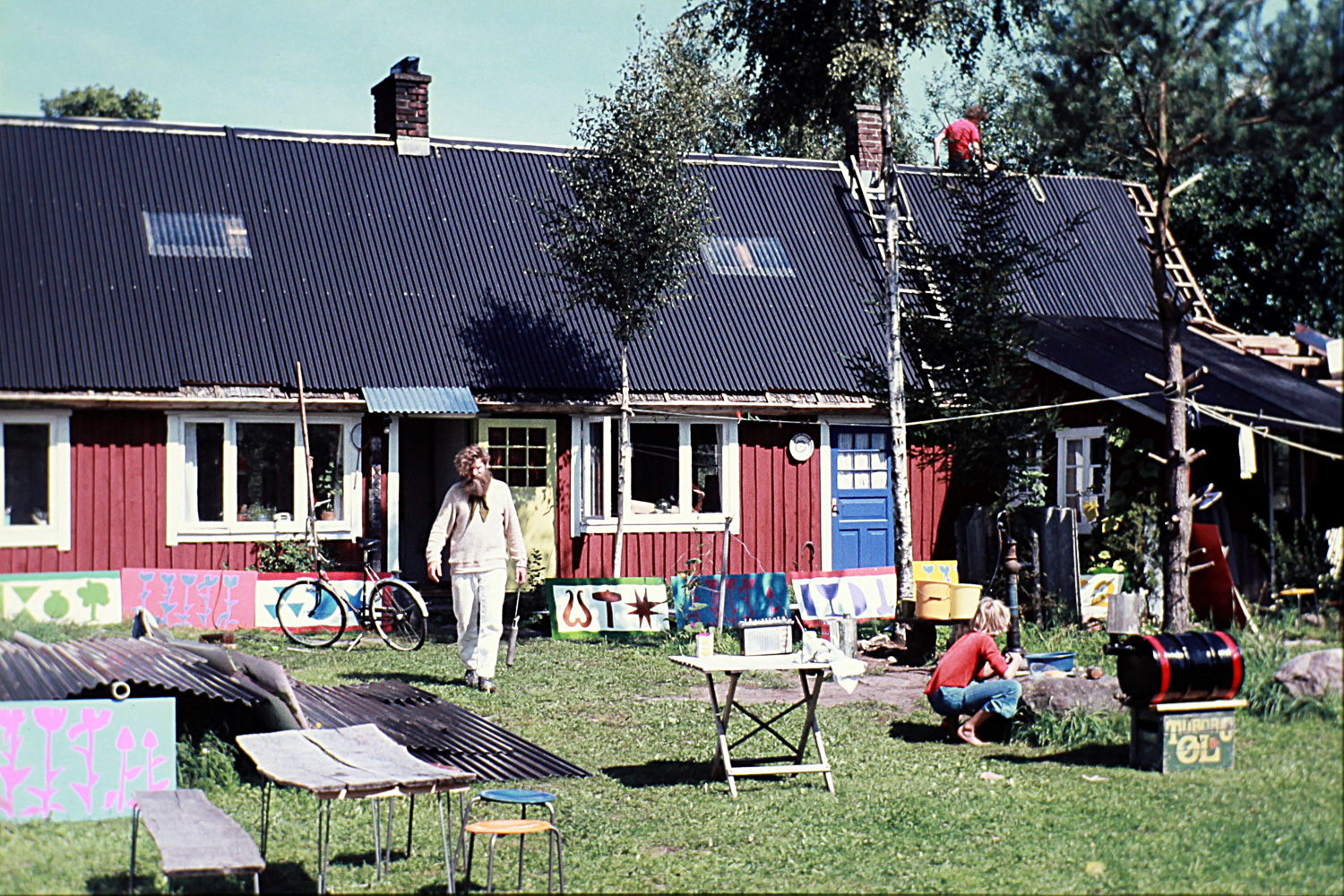
The family home in Ekeröd during work on the decoration of Carlsberg's bottling hall, 1977
Photo: Aase Seidler Gernes
The Experimental Art School 1965-68 − happenings, exhibitions, and works
When Poul Gernes returned to the Ex-shool after his long journey abroad, he once again assumed a central role in what no longer resembled a school but rather a communal workspace.
He immediately became involved in organizing happenings, which were now taking place with greater frequency. The early happenings in the school’s premises were arranged by the Fluxus artists such as Arthur Köpcke and Eric Andersen. But in 1964, Bjørn Nørgaard joined the school as a student, and composer Henning Christiansen became an active member, bringing in his German contacts, such as Joseph Beuys. Writer Hans-Jørgen Nielsen and journalist Erik Thygesen also became part of the group that organized and performed happenings, particularly at upper secondary schools across the country.
Poul Gernes was an outstanding performer in many of the Ex-school’s happenings in the late 1960s, and he was often the one who wrote the skeletal scores for these events. Three highly different and unforgettable ideas for these happenings were conceived by Poul Gernes himself.
The first was his Paper Happening, which he staged from 1965 onwards on several occasions. In complete silence, he wrapped himself from the bottom up in wrapping paper, eventually disappearing into a paper cone. He then cut himself free with a single move, thereby destroying the cone sculpture.
The second happening was quite simple: Poul Gernes built a wall of cardboard boxes and then dismantled it again – wearing a sweater in a contrasting colour.
The third famous work was created by Poul Gernes for the happening festival Tilstande (State of Affairs) in the Ex-school basement gallery at St. Kongensgade 101. Here, he wallpapered the walls and windows of the front room with machine paper painted in eight horizontal colourful stripes. This created a unique backdrop and visual companion to Joseph Beuys’ performance.
Erik Steffensen summarizes: “The striped room in Store Kongensgade was the culmination of many years of work aimed at moving the image away from the easel while retaining the work’s expressive potential. Insights into space and surface had been underway for a long time, and certain works bear evidence of profound understanding of the life of materials and colours, driven by practical experiments. Movement, psyche, time, and space became visible objects in these experiments, which sought to liberate art from its traditional confinement to categories like sculpture and painting.” [note]Erik Steffensen: Poul Gernes – Monografi. Copenhagen 2000, p.87-8.
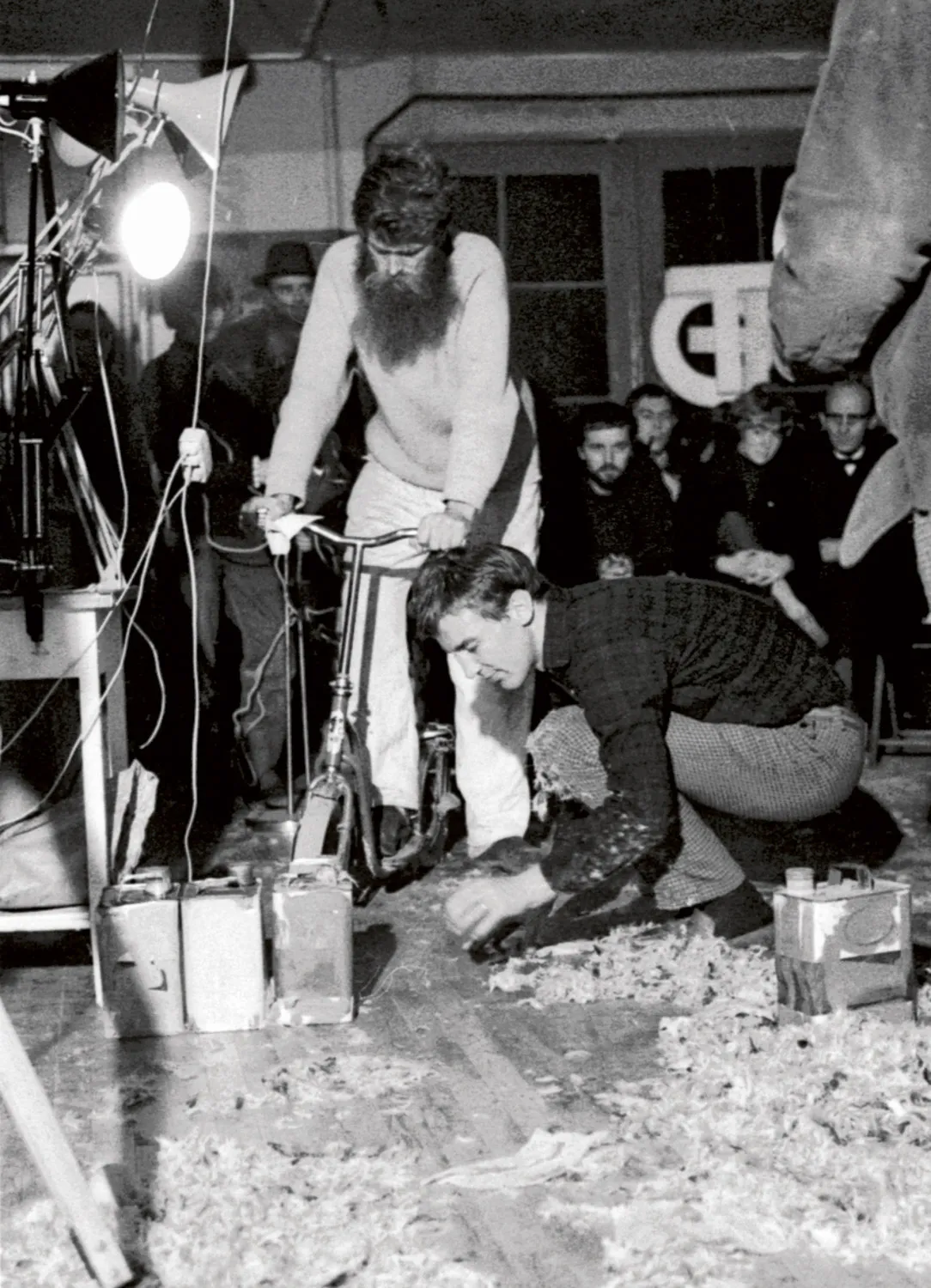
State of Affairs, happening festival, October 1966. Behind Poul Gernes and Hans-Jørgen Nielsen, Joseph Beuys with hat
Photo: Robert Nielsen
In addition, there were exhibitions, which came in quick succession. First, Biludstillingen (Car Exhibition) in 1965 at Copenhagen Municipal Library, featuring large accumulations of materials. Next, at the same venue, Menneskeudstillingen (Human Exhibition) was set to feature large collages, clothing objects, and photos. However, the library’s board decided to cancel the exhibition shortly before its planned opening.
In 1966, Poul Gernes created a huge striped painting for Charlottenborg’s Spring Exhibition, composed of masonite panels painted with synthetic lacquer. The work was installed in the exhibition building’s grand staircase and merged seamlessly with the architecture as a decorative feature.
That same year, Poul Gernes exhibited again in Charlottenborg’s foyer at the Nordic Youth Biennale. He presented a large series of paintings with squares woven into a checkerboard pattern using coloured paper strips. Additionally, as a sculptural unifying element, he erected a ceiling-high orange column.
In 1969, the Royal Danish Academy of Fine Arts celebrated the 200th anniversary of the first exhibition at Charlottenborg by inviting artists to participate in a working art gathering. For the artists (and other visitors), Poul Gernes constructed a large bathroom from wooden beams and semi-transparent plastic, complete with communal showers and a sauna. The utility of the art institution was almost fully realized.
Poul Gernes participated in far more exhibitions than can be listed here. His contributions ranged from gigantic paintings and serial sequences to large collages and extensive tableaux. For Poul Gernes, every exhibition was an opportunity to experiment with materiality, spatiality, and artistic expression. Site-specific projects such as the Large Stripe Painting at the landing of the Charlottenborg staircase, the Cardboard Box Tower, and the Dreamship, among others, are now regarded as significant artworks in their own right but were originally created as statements in process.
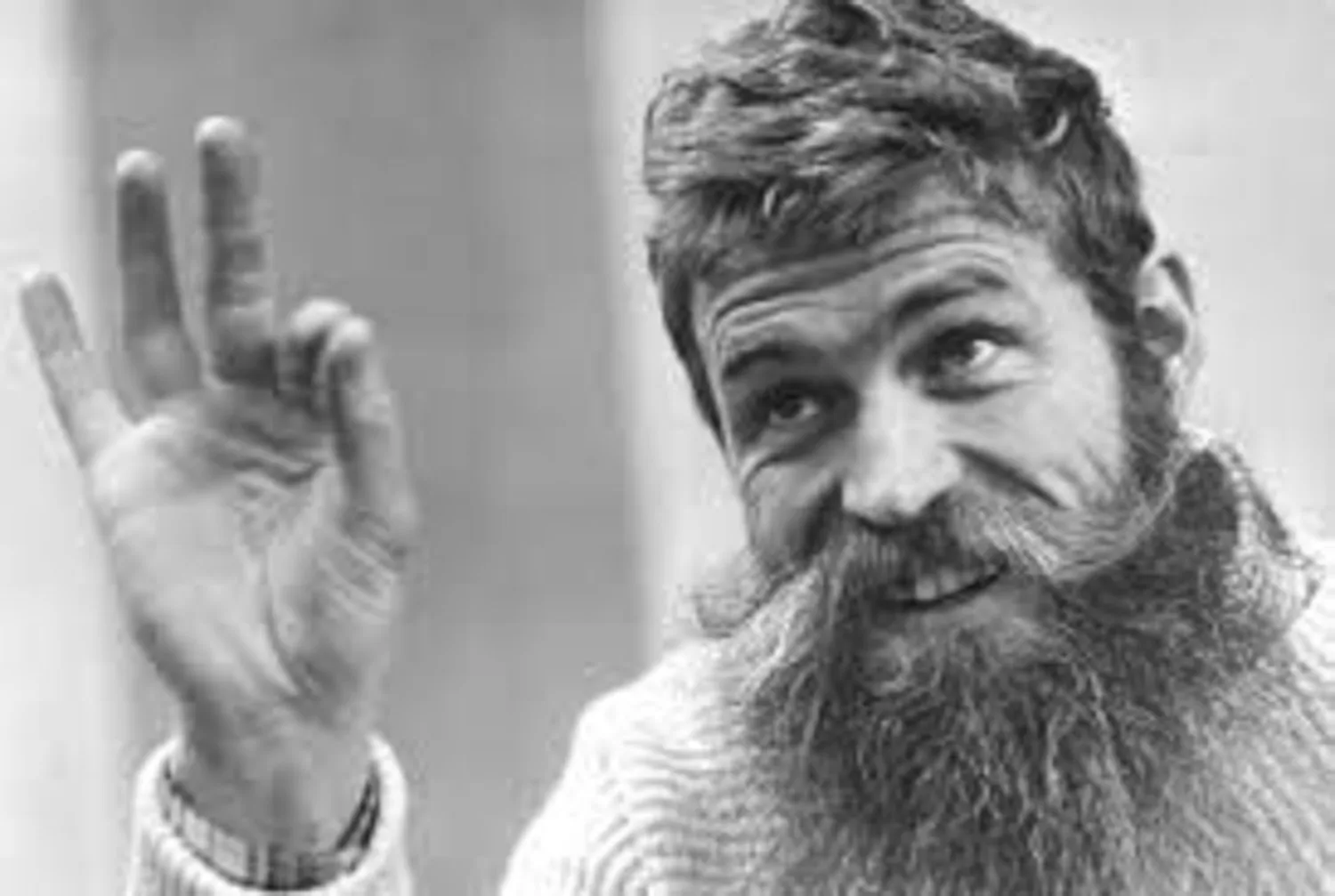
ca. 1967
Photo: unknown
After the Ex-school
At the Ex-school, the artistic process was always embedded in social initiatives and political activism. Striking a balance between artistic creation and social engagement was, of course, an individual consideration, but Poul Gernes participated in an exceptionally broad range of activities – from collective responsibility for teaching and experiments to large-scale exhibitions and social initiatives. Over the years at the Ex-school, he developed the artistic style that would define his continued artistic career.
The 1960s were a period of rapid artistic development for Poul Gernes. From his early exploratory and experimental works, he ended the decade working across three platforms. The first was as a visual artist, creating serial paintings with simple motifs and ornaments like stripes, dots, and crosses.
The second was as a graphic artist, notably with his Self-portrait (1-16) in a lithographic series in Hvedekorn, which earned him significant recognition in artistic circles. [note]Hvedekorn – Tidsskrift for litteratur og grafik. 40. årgang nr. 2 1966.
The third was through large, often collage-like exhibitions that, alongside “traditional” artworks, incorporated everyday phenomena such as cars, boats, comics, and advertisements.
Etchings, lithographs, linocuts, silkscreen prints, offset prints, texts, and designs for catalogues, magazines, and books poured out of Poul Gernes’ hands in large numbers, often in connection with exhibitions, artist portfolios, and book publications. Eks-skolens Trykkeri, the Ex-school’s print shop, was his preferred partner for collaboration.
In 1972, he designed the cover with a colourful flower for the MagnaPrint book series for the visually impaired, published by Borgens Forlag and Ny Dansk Litteraturselskab.
That same year, he exhibited Forslag til EF-flag (Suggestions for a flag for the European Community) in the Daner Gallery in Studiestræde. The work consisted of banners made from fabric collages, embroidery, and textile prints, created in collaboration with Aase Seidler Gernes. Leading up to the referendum on Denmark’s entry into the European Community, they designed proposals for a shared flag featuring various motifs (many with a good dose of humor): a peace dove, an ice cream cone, Adam and Eve, patchwork flowers resembling an atlas of the member countries, and more.
As the artists of the Ex-school gradually developed their individual artistic expressions and identities, Poul Gernes joined new exhibition groups, including Arme & Ben (Arms & Legs), which comprised Poul Gernes, Erik Hagens, Per Kirkeby, Bjørn Nørgaard, Lene Adler Pedersen, Ursula Reuter Christiansen, and Richard Winther, as well as composer Henning Christiansen.
At Arme & Ben exhibitions, he contributed the following works:
• 1976: At Kunstmuseum Luzern, Poul Gernes presented a series of masonite paintings based on the Swiss flag, a series based on the Danish flag, as well as large paper cutouts.
• 1977: At Aarhus Kunstbygning (Kunsthal Aarhus) he created a giant paper flower.
• 1978: At the Willumsen Museum in Frederikssund, he constructed a massive maypole and hung large pieces of (fabric) licorice allsorts from the ceiling.
Between 1973 and 1976, Poul Gernes and Per Kirkeby undertook a feature film project titled The Normans – A film about the vikings. Before the screenplay was finalized, the film crew began by creating as authentic an environment as possible, including dwellings, boats, and clothing. The film aimed to reflect the living conditions of the Vikings, but in many cases where concrete knowledge was lacking, scenes featuring contemporary narratives and explanations were included. When the film premiered in cinemas, critics and audiences found it difficult to understand its intent and experimental format. It was too avant-garde for its time. [note]Troels Andersen: “Gernes.” In Karola Grässlin (ed.): Poul Gernes. Kunstverein Braunschweig 2002, p. 26-31.
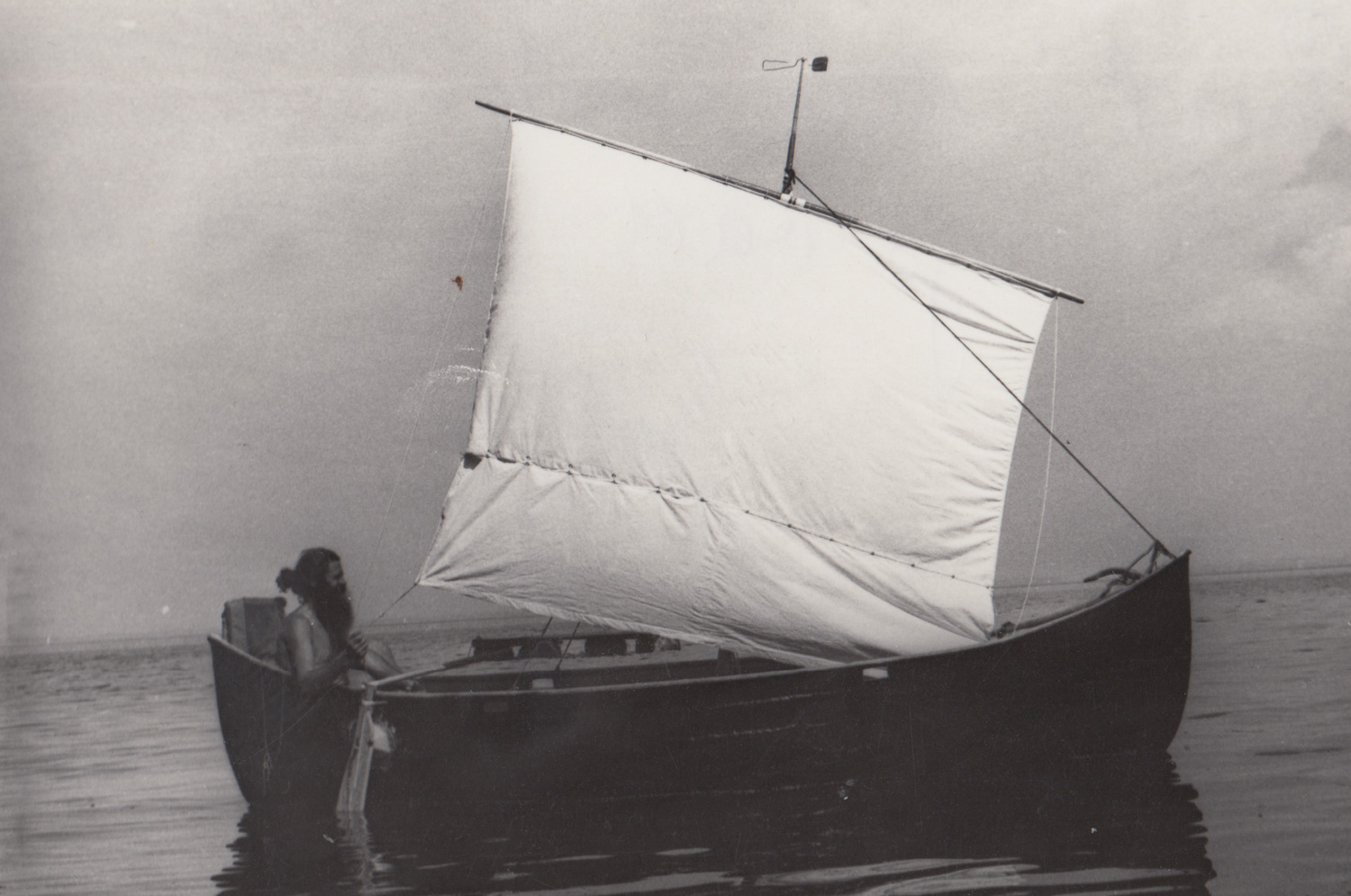
Poul Gernes in one of the boats he built for The Normans – A film about the Vikings, ca. 1972
Photo: Jesper Gernes
Herlev Hospital 1968-1976
The medicine of colour was the overarching intention of Poul Gernes’ colour scheme for Herlev Hospital. [note]Ulrikka S. Gernes & Peter Michael Hornung: Farvernes Medicin - The Medicine of Colours – Poul Gernes og Amtssygehuset i Herlev. Copenhagen 2003. Gernes was awarded the project in 1968 following a closed competition and carried it out in close collaboration with the architectural firm Selchau, Bruël, and Bornebusch.
Initially, the competition focused on the hospital’s foyer. The idea was that the large entrance hall should, from the moment of arrival, provide encouragement and warmth to patients and visitors. The decoration consisted of 50 large masonite panels stretching from floor to ceiling, as well as four folding doors. The motifs on the paintings and doors were repetitions and variations of works from earlier exhibitions but executed on a larger scale. The range of colours was almost cacophonic—not harmonious in the traditional sense, but the images clashed in surprising ways. This brought energy and attention, as targets, letters, paper-cut motifs, checkered patterns, and dots formed a symphony of colour and optimism.
Thanks to the artist’s persistent conviction and exceptional persuasive skills, the decoration of the foyer was expanded to include the colour design of the hospital’s 25-story interior corridors, medical treatment rooms, patient wards, furniture, and curtains.
A close collaborator throughout the process was his wife, Aase Seidler Gernes, who, as a textile printer, had extensive knowledge and experience with colours. She gave up her own production to dedicate herself fully to the work on Herlev Hospital. [note]Ulrikka S. Gernes: “A mother is a story without a beginning.” In Ulrikka S. Gernes, Nina Hobolth & Maj-Britt Willumsen (ed.): Aase Seidler Gernes. Frederiksberg 2015.

Aase Seidler Gernes painting preparatory studies for the decoration of Herlev Hospital
Photo: Jesper Gernes
The couple’s first step was to create a mock-up model in a ward at Gentofte Hospital in 1970. Over the course of a year, they tested the effects of colours and textiles on patients and medical staff.
After an enormous amount of work, the project was completed with the hospital’s inauguration in 1976. The entirely unique and colour-harmonious decoration was realized thanks to Poul and Aase Gernes’ artistic vision, uncompromising dedication, and practical ingenuity. Their success was also due to the spirit of the time, which emphasized optimizing public spaces to promote community well-being.
The colours were chosen based on the orientation of patient rooms relative to the cardinal directions and the incoming light. To the north, cool tones such as blue and green were used; to the south, warm reddish hues; to the east, yellow (sunrise); and to the west, orange. Curtains were also designed differently depending on the room’s orientation, and there were both day and night curtains to block excessive light or shut out darkness and the outside world.
Another colour system was devised according to the functions of the treatment departments: for example, the maternity ward was light green, the blood bank oxblood red, and so on. Signs, doors, panels, and floors were assigned functional colours, and the colours in the corridors reflected the primary directions of various treatment areas.
The beautiful intention behind the decoration of Herlev Hospital was to create a sense of humanity, and this was achieved despite the enormity of the task. It is staggering to consider that 65 kilometers of pink-coloured skirting boards and 10 kilometers of custom-printed curtain fabric were specially produced, and that 4,500 doors to 3,700 rooms were painted in 21 different colours!
Herlev Hospital stands as the most complete monument to Poul Gernes’ artistic genius and serves as a testament to how space, function, and colour in harmonious, yet dynamic expression can soothe and enrich our lives.
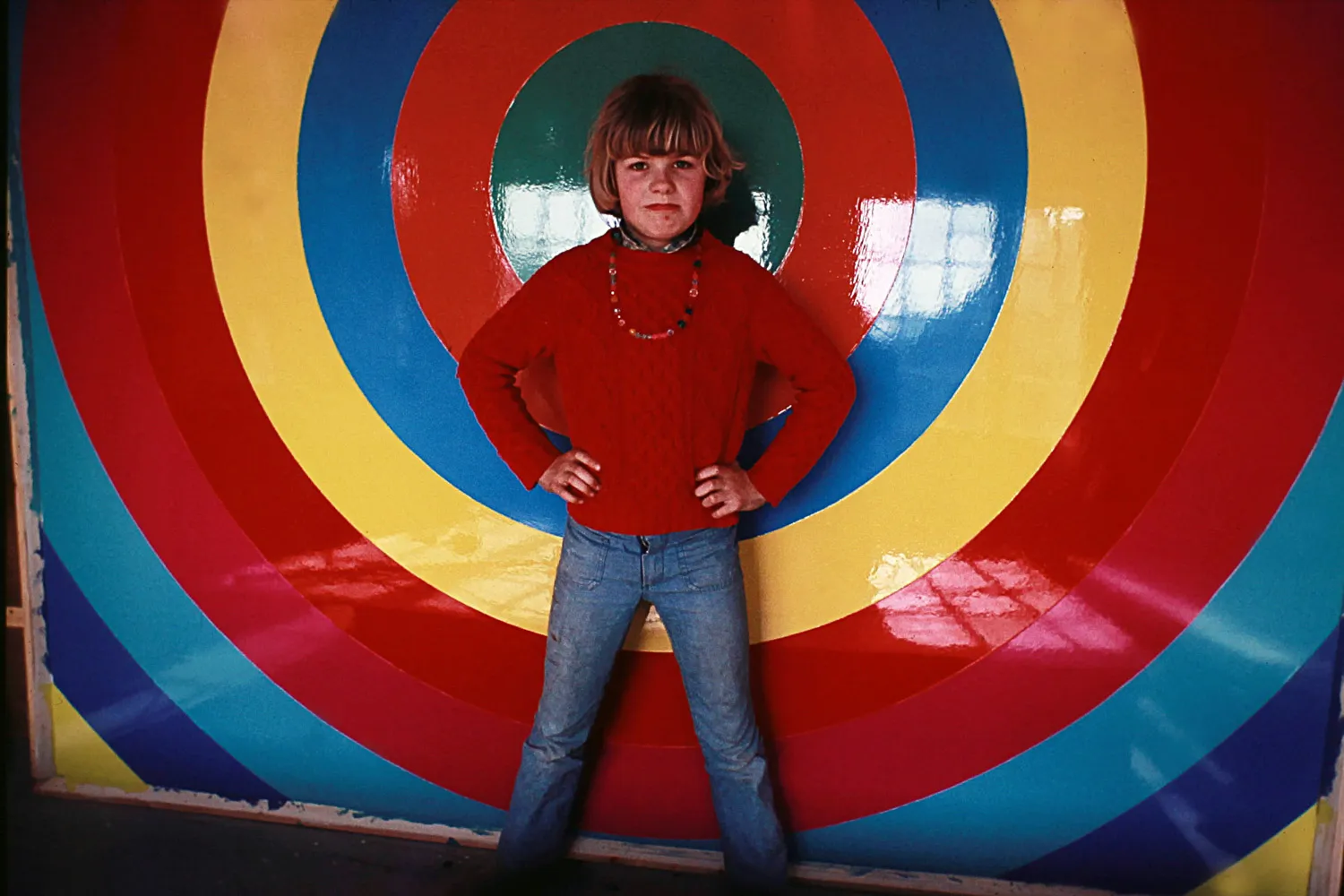
Ulrikka Gernes in front of painting for Herlev Hospital's foyer, 1973
Photo: Jesper Gernes
Artistic work through a collective
In 1970, Poul and Aase Gernes, along with their two youngest children, moved into a large house on the North Zealand coast to explore an alternative to the nuclear family. The first attempt failed, but in 1972, Birgit and Knud Pontoppidan joined Poul and Aase Gernes to start a project aimed at helping former drug addicts overcome their dependency. Hard physical labor was placed at the center of the initiative. The organization Hjælp (Help) sought out and renovated holiday camps across Denmark, working in teams composed of one adult and one client. The project achieved a 50% rate of reintegration, which can be considered a success. The results in the camps were also noteworthy, as they were painted in bright, vibrant colours. However, tensions arose between the two families, the children struggled, and the organization dissolved. [note]Birgit Pontoppidan: ”Fællesbilleder.” In Lilith (ed.): Billedet som Kampmiddel – Kvindebilleder mellem 1968 og 1977. Copenhagen 1977, p. 10-12 og 21-28.
Poul and Aase Gernes did not experiment with communal living again. However, Poul Gernes remained deeply interested in collective working methods. When he became a professor at the Royal Danish Academy of Fine Arts in Copenhagen in 1985, at the Department for Wall and Space, his intention was to do site-specific projects with a team of students. This working method, however, did not appeal to the students. With a special dispensation from the admissions rules, Poul Gernes was allowed to recruit his own team of assistants. They formed the core of what he once termed the Gernes painting company, which also included his wife, Aase Seidler Gernes, and their daughter, Ulrikka Gernes.
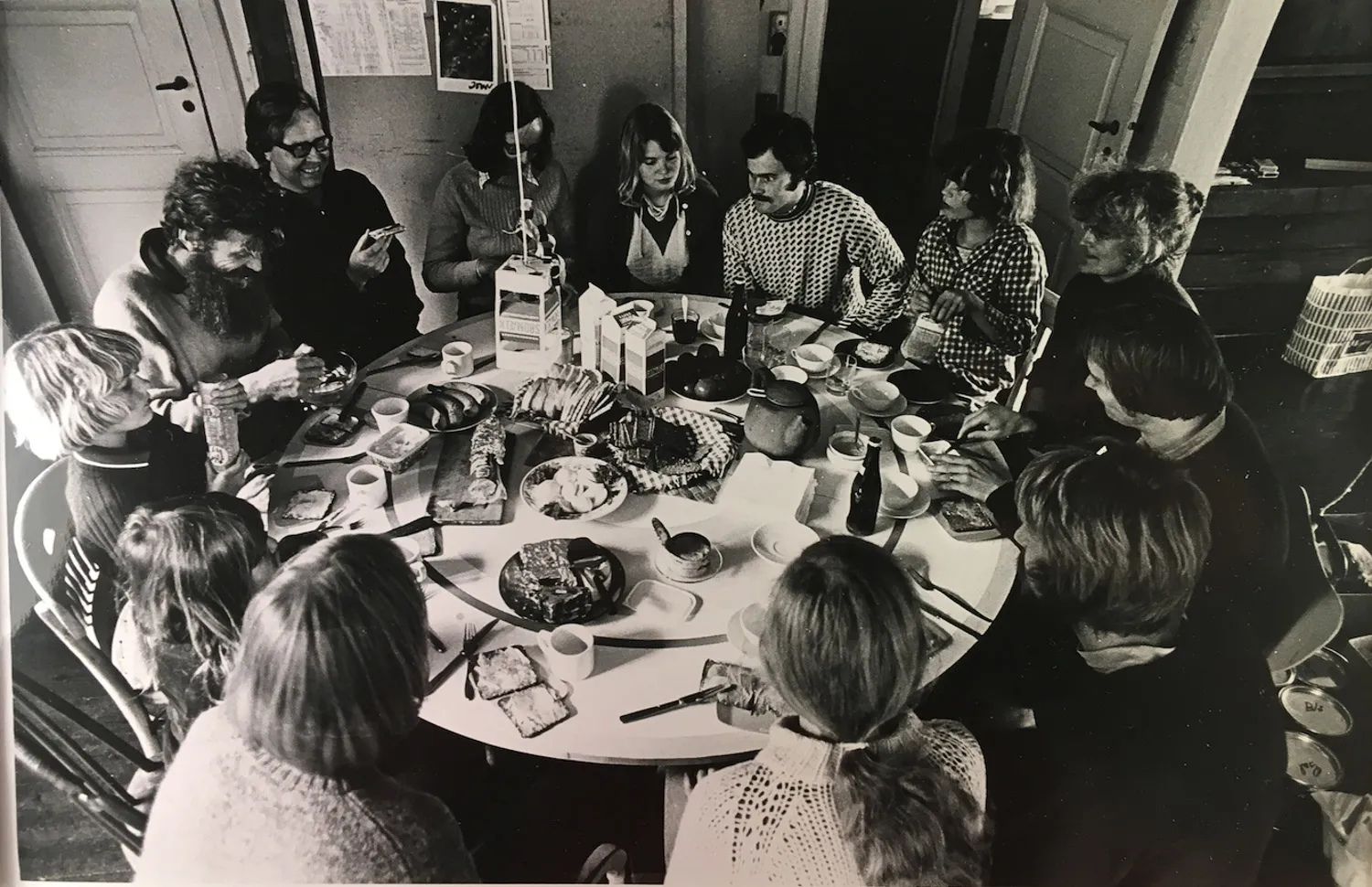
Extended family, 1971-2. Sitting around the table are Poul Gernes, John Hunov, Birthe Inge Hunov, Maude, Peter, Konrad Gernes, Aase Gernes, Per Kirkeby, Kenneth Svensson, Anne-Sofie Gernes, Kerstin, Rebecca Kirkeby and Ulrikka Gernes
Photo: Jesper Gernes
Site-specific decorative works 1977-1996
Following the colour design of Herlev Hospital, which cemented Poul Gernes’ reputation as a master of colour, there was immense demand for his art – not as individual works for sale but as site-specific decorative projects. In the following decades, he carried out approximately 150 commissions for educational institutions, residential areas, workplaces, and cultural centers. [note]Finn Thybo Andersen: Poul Gernes Decoration Projects 1970-2006 – Mottled cow has many spots. Copenhagen 2016.
Many of these projects came about because art and colour enthusiasts outside the traditional art institutions reached out to Poul Gernes. The site-specific approach that Poul and Aase Gernes applied to each project, whether large or small, and the dialogue that took place before and during the realization of these decorations left an unforgettable impression on those involved. Unfortunately, over half of these decorations have been lost, but many significant works still remain.
There seemed to be no limit to Poul Gernes’ desire to decorate the world, as evidenced by a 1993 project to decorate an entire town: Helsinge. However, this plan was never realized.
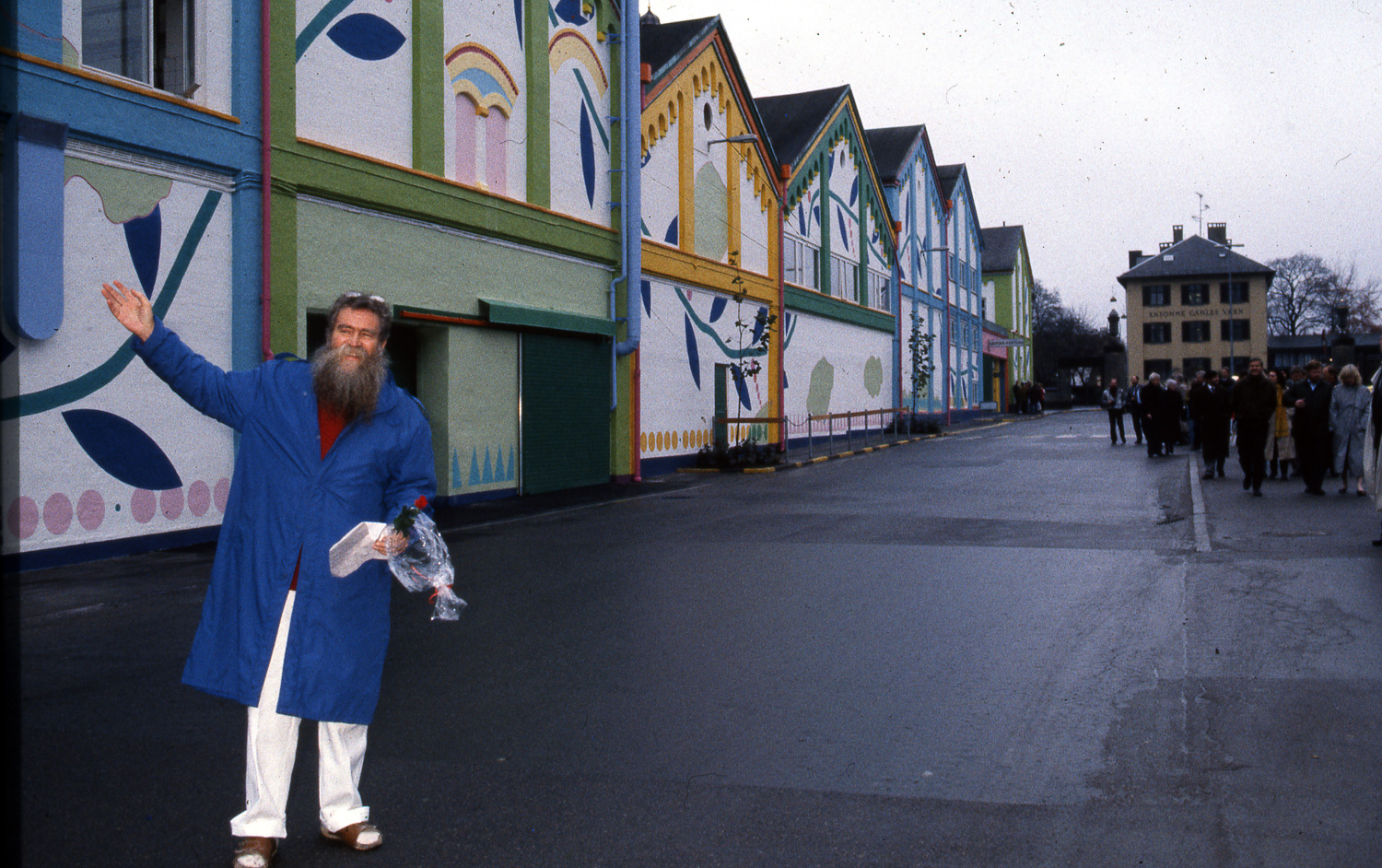
At the inauguration of his Tuborg decoration, 1990
Photo: unknown
A series of examples (some of which, unfortunately, no longer exist) are listed below in chronological order:
• Flügger Paint Factory, Kolding, 1977. This decoration was created at the end of a production hall on the first floor and was the first project completed after Herlev Hospital. It consists of several large square wall paintings in the same “style” as the foyer at Herlev, along with colour design and decorated pallets.
• Panum Institute, Copenhagen N, 1980-81 and 1986. This decoration is located in the building’s basement in the the macroscopy department. The first part includes six study rooms, and corridors. The paintings' motifs are plant forms whose stems and leaves resemble Rorschach test patterns, mirrored symmetrically along an axis. Five years later, the dissection hall, passageway, and chapel were also decorated. Large, stylized flowers are painted in the corridors, and grape clusters adorn the chapel.
• Morsø Theatre, Nykøbing Mors, 1982. The stage curtain – aside from the curtains at Herlev Hospital – is an exceptional textile work among Poul and Aase Gernes’ decorations. Measuring 6 x 21 meters, it bursts with line-painted flowers floating on a white background. A blue velvet border frames the swirling flowers.
• Bavne School, Dalby near Haslev, 1983. The structure of the school’s assembly hall determined the decoration, which is located above the supporting columns. It consists of several smaller wooden reliefs with painted flowers on the long walls and a large relief on the end wall featuring a vase with flowing leaves and flower branches. In subsequent years, Poul Gernes preferred ceramic tiles over wood.
• Rebæk Søpark Student Housing, Hvidovre, 1983-84. The seven-story building, housing 362 rooms, was decorated in the corridors and around each room’s door. The same applies to each of the 22 kitchens and the many elevator lobbies. The linoleum floors were also included into the decoration, which features a wealth of motifs ranging from pure geometric forms to naturalistic elements and paper-cut/stencil painting.
• Horsens Town Hall, Horsens,1985-86. In the red-brick building’s communal and corridor areas, all furnishings up to the second floor were colour-coordinated in Gernes’ light palette. The council chamber was enriched with a metal sculpture of giant, painted goose feathers, and the wedding hall became a festive paradise of bouquets, cherry branches, and flower garlands.
• Nexø School (now: Paradisbakke School), Bornholm, 1985-94, in several stages. The walls in the library and teachers’ lounge were adorned with large leaf decorations. Later, corridors and classrooms were painted, culminating in a unique starry ceiling—a connecting corridor featuring a deep blue ceiling scattered with stars.
• Lille Grundet Housing Cooperative, Vejle, 1988-92. The 20 wooden-clad residential houses were painted pink, with smaller extensions in other bright colours, and long ceramic tile bands were installed on the facades. The communal house – a former main building – was given exterior colour sections on the walls, window frames, and continuous facade bands. Inside, the 21 doors were each painted in a distinctive colour and framed with lively stencil patterns.
• Palads Cinema, Copenhagen, 1989. The exterior colour scheme is dominated by warm salmon, pink, yellow, and orange hues, and the colour fields on the large building follow the architectural division of sections with white pilasters. Bright blue, turquoise, and purple horizontal facade bands are key markers on the expansive facades. Palads has become an icon of an alternative, lush building culture and remains a subject of ongoing debate.
• Ordrup Upper Secondary School, Charlottenlund, 1991. A school on the verge of closure turned its fate around when the dilapidated building underwent a complete makeover. This was achieved through a collaboration between Poul Gernes, his team, the school’s teachers, and students. The walls of the stairwells were adorned with floral vines, woodwork received vibrant colours, corridors and classrooms were painted, and new floors in bold hues were installed.
• Gurre Bunker, North Zealand, 1992–93. This two-story-deep bunker, built during the cold war in 1961, was renovated and decorated by Poul Gernes in a simple yet beautiful way. Stairwells were embellished with flowers using stencil painting. In the corridors and living areas, the white concrete walls were preserved, but the furnishings – doors, frames, panels, and cabinet doors – were painted in vibrant colours. Residents also encountered small, picturesque symbols in the rooms, such as star flowers, small circles, and squares, offering a human touch in a cold environment.
• Vestervang School, Herning, 1994. The challenge was a dominant and “dull” wall tile in one of two stairwells. Poul Gernes chose to decorate the walls above the yellow tiles across two floors with giant stylized branches and a decorative frieze. In the other stairwell, large colour fields approximately 1.5 meters high were applied, and doors, railings, window frames, and ceiling beams were painted. Several classrooms were also adorned with floral motifs and panel decorations.
• Competence Center for Youth and Adults with Disabilities, Viborg, 1995. The last decoration Poul Gernes completed was for a gymnasium and a warm-water pool. The gymnasium was given a simple and warm colour scheme, with the multicoloured doors adding a welcoming energy. The pool is surrounded by white walls decorated with long blue leaf stems, from which large yellow-orange and blue flowers nod gently in a swaying motion. The window openings are painted yellow, giving the space an enchanted glow.

Palads Cinema in November 1989
Photo: Aase Seidler Gernes
More exhibitions, more works
Alongside his many decorative projects, two retrospective exhibitions of Poul Gernes’ art were presented.
The first took place at Sophienholm in Kgs. Lyngby in 1979–80, where the neoclassical estate was filled with artworks from floor to ceiling. It was curated by Poul Gernes himself, and on this occasion, he also created a catalogue featuring black-and-white photos documenting his works, ranging from his youthful paintings to his contemporary creations. The catalogue also included two articles by his old colleagues from the Experimental Art School, Per Kirkeby and Bjørn Nørgaard, each writing a heartfelt tribute to Gernes’ significance for them. [note]Poul Gernes (ed.): Poul Gernes på Sophienholm. Lyngby-Taarbæk 1979.
The Sophienholm exhibition was followed in 1983 by Paul Gernes’ Big and Old Things at Nordjyllands Art Museum in Aalborg, also organized by Poul Gernes. In the venue’s high-ceilinged halls, it was possible to showcase his large and extensive works, including series of paintings, sculptures, and installations. For the occasion, Gernes also wrote a catalogue featuring a sharp critique of contemporary art. [note]Poul Gernes: “Isn’t it about time to change course?” In: Paul Gernes' store og gamle ting. Nordjyllands Kunstmuseum Informationsavis nr. 124. Aalborg 1983.
Countless sculptural projects emerged from his time at the Ex-school, including folded metal plates, scrap iron, alphabets of shapes, cardboard box walls, and installations of paper and fabric. Around 1968, Poul Gernes also began working with plaster sculptures: a giant licorice pastille, an impression of his own naked rear end, casts of milk cartons, cream pies, and splatter figures. Several of his decorative projects featured large iron and stone sculptures with carved circles and painted, engraved symbols.
Starting in the early 1980s, Poul Gernes regularly traveled to the marble quarries and workshops in Pietrasanta, northern Italy, where he created a series of sculptures in both smaller and larger formats: chess pieces, columns, and pillow sculptures. Shortly before his death in 1996, he completed two figurative sculptures, the female figures Big Rosa and Little Rosa.

In Pietrasanta 1995
Photo: Anders Krüger
Public and Private
For 35 years, Poul Gernes was a visual artist who stood out as a clear voice in the public sphere. He participated in exhibitions and artistic actions. He wrote opinion pieces with proposals for decorations and articulated his views on art policy. [note]Poul Gernes: Forskningsforpligtelsen 1 (Copenhagen Kunstakademiets Arkitektskole 1988) is a compendium containing seventeen of his articles, public lectures and interviews. His teaching as a professor at the Royal Danish Academy of Fine Arts broke away from the usual individualistic practices, and the many decorations he completed with his team were radically different from other public and private decorations.
His paintings – industrial lacquer on masonite panels in standard sizes – were unsigned, a practice that marked his rejection of art as a commodity. Similarly, the many decorations carried out by the Gernes painting company, involving Poul, Aase Gernes, and their team of assistants, were also unsigned. Graphic prints were occasionally signed, and his name, either “Poul” or sometimes “Paul,” often appeared in text as the creator of the design, motif, and colour schemes. Articles and opinion pieces in newspapers and journals always carried his signature, and they were often co-written with others.
Thus, Poul Gernes was neither invisible nor anonymous during his lifetime. However, he maintained a clear and deliberate distance from the commercial art world as it unfolded in galleries and art fairs.
There exists a wealth of documentary material, particularly photographs, from Poul Gernes’ life. His striking and distinctive appearance – the harmonious figure with a large beard and lively eyes – was highly photogenic, and he willingly posed in various postures to bring presence to a situation.
Poul Gernes’ clothing, for many years, reflected the artisan tradition from which he came and which he deeply respected. White kansas-brand work trousers, socks with sandals, hand-knitted sweaters and hats, and traditional windbreakers during the colder months were his preferred attire.
Poul Gernes lived an ascetic – almost puritanical – lifestyle. His home in Sweden was not equipped with many modern conveniences, but there was harmony in the low-ceilinged country rooms, with their brightly painted furniture and beautiful textiles, many of which were created by Aase to decorate the home. The untouched nature surrounding the house and garden on the small rural farmstead provided an attractive backdrop for various projects involving iron and stone sculptures.
Poul Gernes’ appearance and personality can be illuminated through the many photographic recordings of collective work processes, from the Ex-school to his site-specific decorative projects. Private photos also capture the arc of his life, from youthful vigor to the effects of aging and illness. In the last 15 years of his life, Poul Gernes suffered from a severe kidney disease, partially alleviated by a kidney transplant.
Despite his physical frailty, Poul Gernes – supported by his life partner Aase – relentlessly devoted all his energy to his many artistic projects. With his exceptional organizational skills and unwavering powers of persuasion, he was able to bring an extraordinary number of ideas to life.
Poul Gernes passed away from a stroke on March 22, 1996, at the age of 71, in his home.
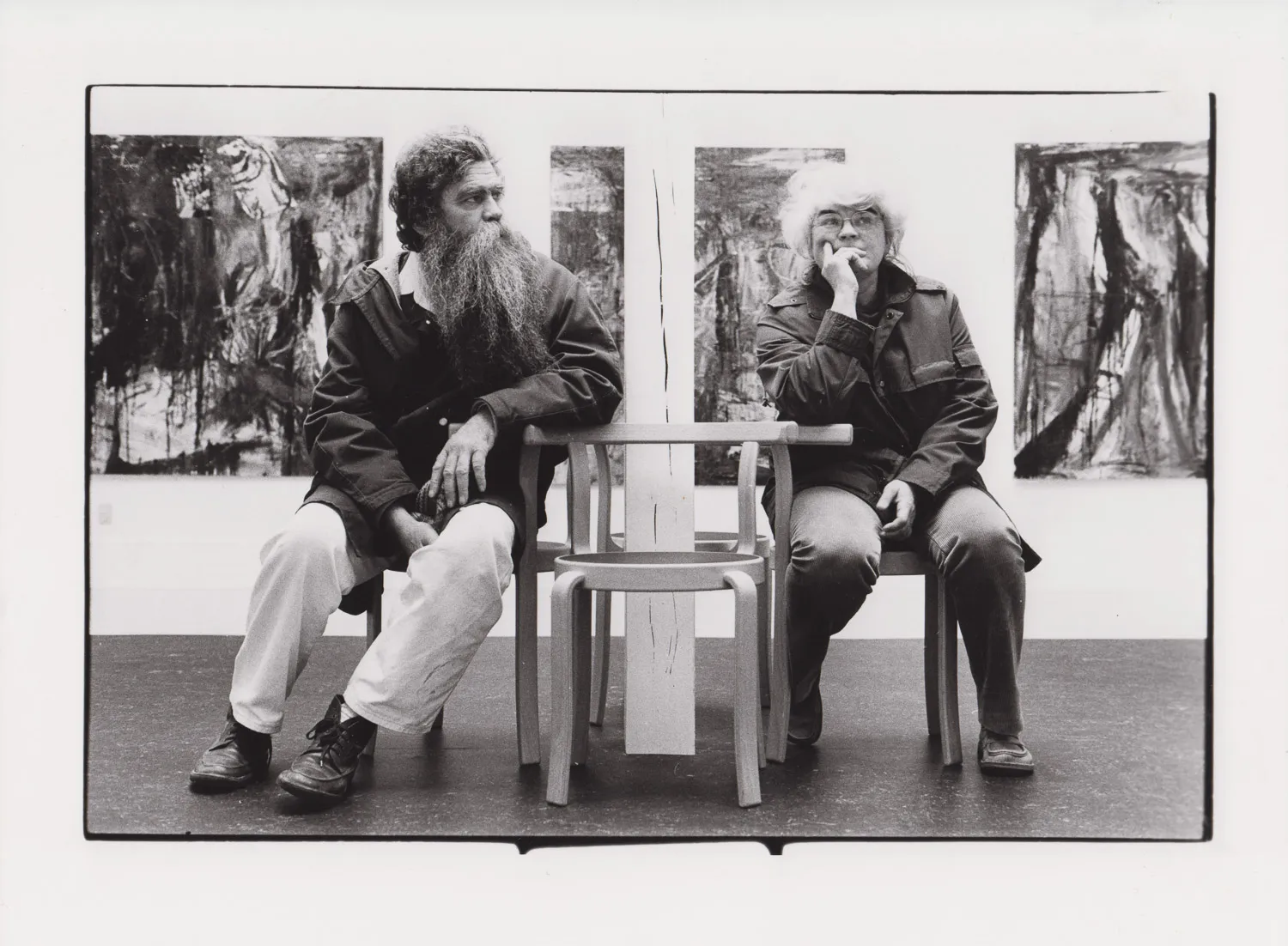
Poul and Aase Gernes at Horsens Art Museum's Erik A. Frandsen exhibition, 1986
Photo: Ulrikka Gernes
Travels
Poul Gernes traveled abroad relatively infrequently: the longest journey was the year-long trip in 1964 with his wife and three children through Europe and North Africa. Upon their return, the family settled in southern Sweden, and after a couple of years of collective living in North Zealand, Ekeröd near Ängelholm became the family’s permanent base.
In 1978, Poul Gernes traveled to Egypt. His 8mm recordings from the trip were edited into the film Cairo in 1996 by film director Steen Møller Rasmussen.
In the 1980s and 1990s, he traveled several times to Pietrasanta in northern Italy to work on marble sculptures.
Public positions and honors
• 1977: C. V. Eckersberg Medaillen
• 1979: Three-year work grant from Statens Kunstfond (Danish Arts Foundation)
• 1985-91: Professor at the Royal Danish Academy of Fine Arts, Department of Wall and Space
• 1988: Denmark’s official representative at the Venice Biennale
Statements on decoration and art in public spaces (selection)
• Jane Pedersen: Der er dejligt i Danmark (It's lovely in Denmark). Copenhagen 1971.
• Poul Gernes: “Isn’t it about time to change course?” In: Paul Gernes' store og gamle ting. Nordjyllands Kunstmuseum Informationsavis nr. 124. Aalborg 1983.
• “Art that is not applied art is not art”, Interview with Poul Gernes by Anneli Fuchs og Kirsten Ortved in Skulpturelle Synspunkter, Esbjerg Art Association 1986. Translated and reprinted in Finn Thybo Andersen: Poul Gernes Decoration Projects 1970-2006 – Mottled cow has many spots. Copenhagen 2016, p. 43-6.
• Vagn Skovgaard-Petersen og Peder Skyum-Nielsen: ”The writing and the wall – conversation with Poul Gernes and Georg Jansen”. In Uddannelseshistorie. 27th yearbook for Selskabet for Dansk Skolehistorie 1993, p. 21-26. Excerpt translated and reprinted in Finn Thybo Andersen: Poul Gernes Decoration Projects 1970-2006 – Mottled cow has many spots. Copenhagen 2016, p. 32.
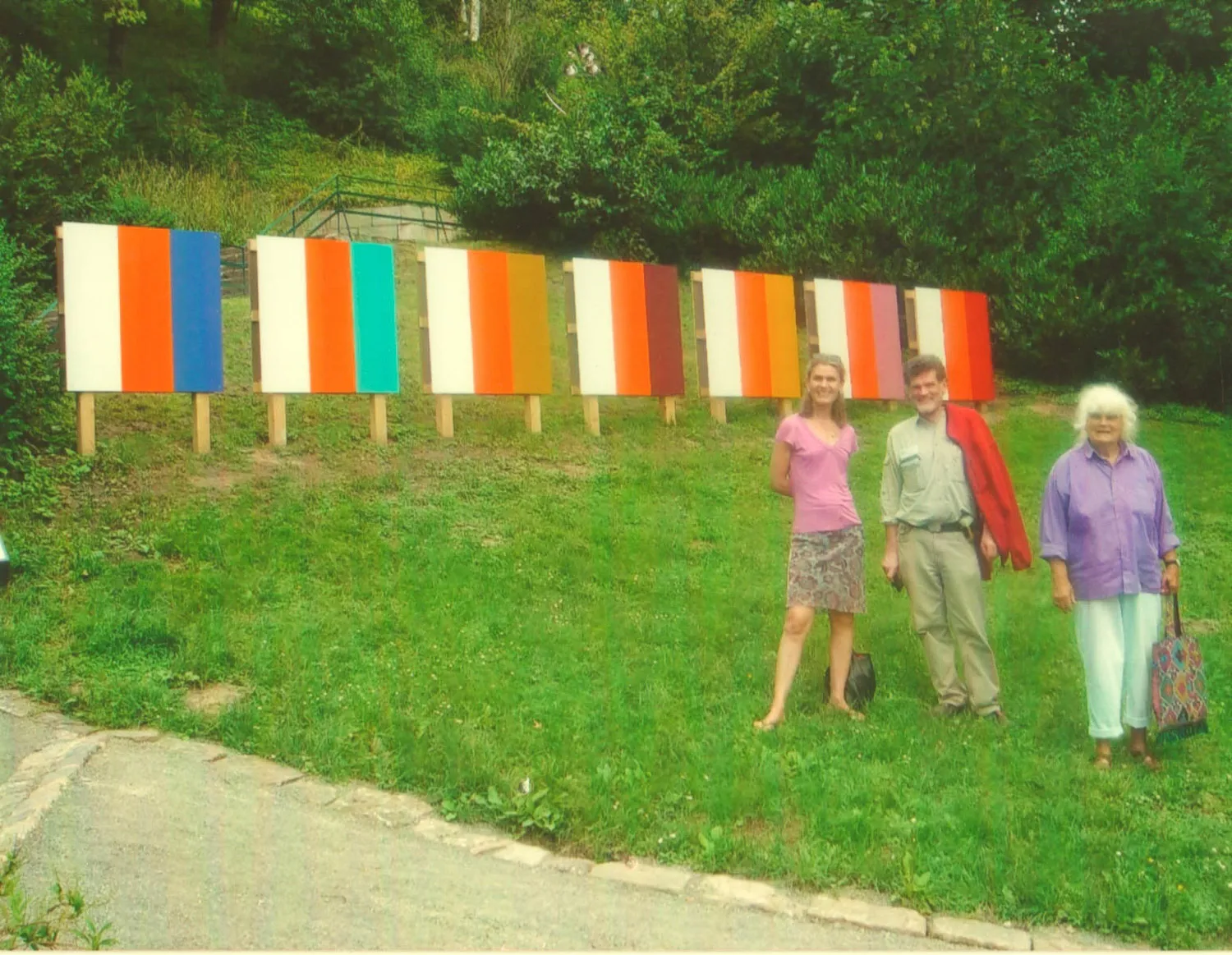
Ulrikka Gernes, Jesper Gernes and Aase Seidler Gernes by the recreated stripe painting series at documenta 12, 2007
Photo: unknown
Legacy – the artistic heritage
In the years following Poul Gernes’ death, interest in his art has remained strong and enduring. This is primarily due to two factors: the establishment of Klara Karoline Fonden (also known as Gernes-fonden) and the deep fascination with his works by several contemporary artists.
Klara Karoline Fonden was established in 2000 as a response to a tragic incident where one of Poul and Aase Gernes’ grandchildren died in a traffic accident. To honor the young girl and give back to life what had been lost with Klara Karoline’s death, Aase and Poul decided to deviate from their principle of not selling artworks. Through donations and subsequent sales, they created an endowment for the foundation.
The foundation’s purpose is “to support artists whose work has a beneficial impact on society” and to assist young artists within the fields of visual arts, music, and literature. Additionally, the foundation supports exhibitions, catalogues, and other initiatives that promote artistic activities and expand awareness of Gernes’ art.
With Aase Seidler Gernes (until her death in 2018) and their daughter Ulrikka Gernes on the board, the foundation has actively facilitated and supported numerous initiatives related to Poul Gernes’ and others’ works. This includes art consultancy, sales, publications, loans, and assistance with exhibitions, among other efforts.
Two visual artists, in particular, immediately embraced the vast artistic oeuvre Poul Gernes left behind after his death.
Erik Steffensen (Danish, b. 1961) published a monograph on Poul Gernes in 2000. With its enthusiastic and empathetic text and rich visual material, the book provides significant insight into Poul Gernes’ life’s work and personality. [note]Erik Steffensen: Poul Gernes – Monografi. Copenhagen 2000. As a natural extension, Erik Steffensen, in collaboration with Aase Gernes, organized a large retrospective exhibition at the North Jutlands Art Museum in Aalborg in 2001, titled Invitation for a Cup of Milk – All the Best from Poul Gernes: Selected Works 1955–1996. [note]Erik Steffensen and Nordjyllands Kunstmuseum (ed.): Invitation til en kop mælk – og alt godt fra Poul Gernes. Aalborg 2001.
Cosima von Bonin (German, b. 1962) became fascinated with Poul Gernes’ works during a visit to Copenhagen. She initiated the idea for a major exhibition, Poul Gernes – Works from the Years 1960 to 1996, at Kunstverein Braunschweig in 2002. The exhibition was bursting with pieces that represented nearly all aspects of Poul Gernes’ work. The presentation – including the catalogue – was inspired by Poul Gernes’ unorthodox Sophienholm catalogue from 1979. [note]Karola Grässlin (ed.): Poul Gernes. Kunstverein Braunschweig 2002; Poul Gernes (ed.): Poul Gernes på Sophienholm. Lyngby-Taarbæk 1979.
In 2001, Cosima von Bonin borrowed a large number of Gernes’ target paintings for her exhibition at Kunstverein Hamburg titled Bruder Poul sticht in See (Brother Poul Sets Sail). [note]Katrin Sauerländer (ed.): Cosima von Bonin - Bruder Poul Sticht in See. Kunstverein in Hamburg 2001. In 2013, Cosima von Bonin’s and Poul Gernes’ works were exhibited together in a major exhibition titled Sidekick at Artipelag Konsthall outside Stockholm. [note]Frida Andersson (ed.): Poul Gernes / Sidekick / Cosima von Bonin. Stockholm, Artipelag Konsthall 2013.
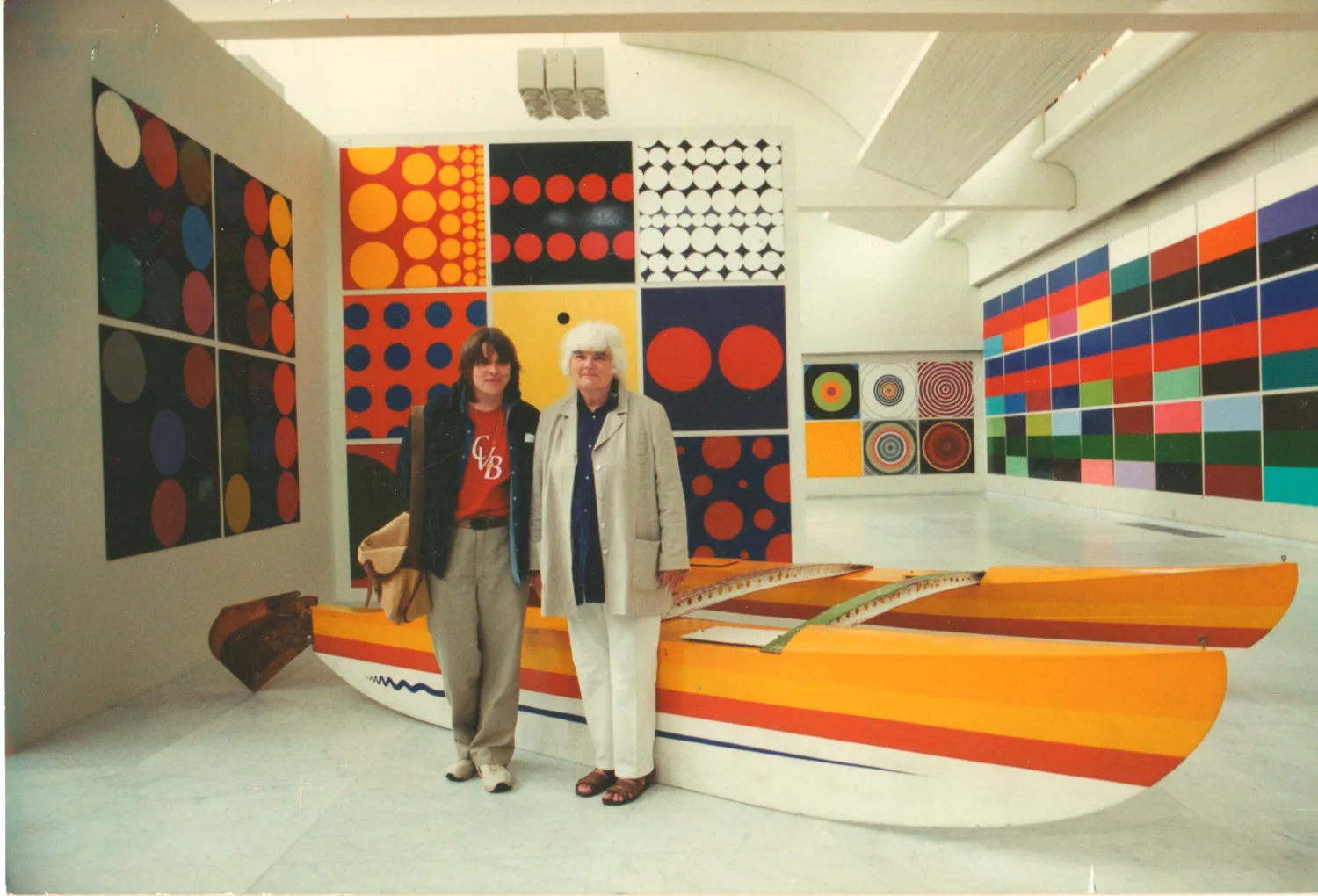
Cosima von Bonin and Aase Seidler Gernes at the exhibition Invitation to a Cup of Milk, curated by Erik Steffensen at Nordjyllands Kunstmuseum, 2001
Photo: Ulrikka Gernes
A pioneering effort went into the exhibition Poul Gernes. Retrospective, organized by Deichtorhallen in Hamburg in 2010, and subsequently also shown at Malmö Konsthall and Lunds Konsthall in 2011. The exhibition was eye-opening in its presentation of the vast scope of Poul Gernes’ artistic oeuvre, ranging from the ephemeral – now reconstructed – exhibition objects made of cardboard and paper to the monumental ornamental paintings. The accompanying book is richly illustrated, with highly insightful essays by authors such as Troels Andersen and Tania Ørum, and the overall presentation of Poul Gernes’ art is impressive. [note]Dirk Luckow (ed.): Poul Gernes. Cologne 2010.
In 2009, two significant publications renewed interest in the 1960s, experimental art forms, and the Ex-school’s brotherhood. De eksperimenterende tressere - kunst i en opbrudstid (The Experimental Sixties – Art in a Time of Change) by Tania Ørum provides a detailed account of the events, ideas, and underlying ideologies of that decade. [note]Tania Ørum: De eksperimenterende tressere - Kunst i en opbrudstid. Copenhagen 2009. Broderskabet - Den eksperimenterende Kunstskole 1961-69 (The Brotherhood – The Experimental Art School 1961–69) by Lars Morell has a narrower focus but also offers a detailed depiction of the school’s founding and its early years. [note]Lars Morell: Broderskabet – Den eksperimenterende Kunstskole 1961-69. Copenhagen 2009.
The exhibition Ex-skolen – Experimental Art School 1961–69, accompanied by a catalogue documenting the school’s activities compiled by Troels Andersen, was shown at Museum Jorn in Silkeborg in 2010. [note]Troels Andersen: Ex-skolen – Eksperiment Kunst Skole. Silkeborg 2010. In 2014, Poul Gernes was represented in the exhibition Anti-Academy at the John Hansard Gallery in Southampton, which focused internationally on alternative educational models in the arts. [note]Alice Maude-Roxby & Joan Giroux (ed.): Anti-Academy. Southampton 2013. Painting the 1960s, shown at Brandts in Odense in 2016, also explored the art scene of the 1960s and the artists who transformed the era, including Poul Gernes and Aase Seidler Gernes. [note]Jakob Kudsk Steensen (ed.): Painting the 1960s – Kunsten Oprøret Hverdagen. Odense, Brandts Museum for Kunst og Visuel Kultur 2016.
Art museums have also seen a resurgence of Poul Gernes’ work, following the renewed ability to acquire his pieces. The NorthJutlands Art Museum in Aalborg (now Kunsten Museum of Modern Art) acquired the Large Alphabet of Shapes and Large Stripe Painting from the Charlottenborg stairwell. Statens Museum for Kunst (National Gallery of Denmark) acquired a series of masonite paintings, 122x122 cm: dot paintings on a silver background. Sorø Art Museum purchased the Dreamship and Louisiana acquired the plaster impressions of Poul’s naked rear, following a major exhibition titled I cannot do it alone – want to join in? in 2016. [note]Lærke Rydal Jørgensen and Anders Kold (ed.): Poul Gernes. I cannot do it alone – want to join in? Louisiana Museum of Modern Art 2016.
Also through his association with several galleries – Galerie Mikael Andersen, Galerie Ben Kaufmann, Galleri Bo Bjerggaard, and Galleri Nicolai Wallner – Poul Gernes’ works have reached a broader audience both nationally and internationally via exhibitions and art fairs.
In 2015, Poul Gernes’ role as an artist was illuminated from a surprising new perspective when a special exhibition of his spouse Aase Seidler Gernes’ textile art at Møstings Hus in Frederiksberg documented their lifelong partnership and the mutual inspiration they provided one another. [note]Ulrikka S. Gernes, Nina Hobolth & Maj-Britt Willumsen (ed.): Aase Seidler Gernes. Frederiksberg 2015.
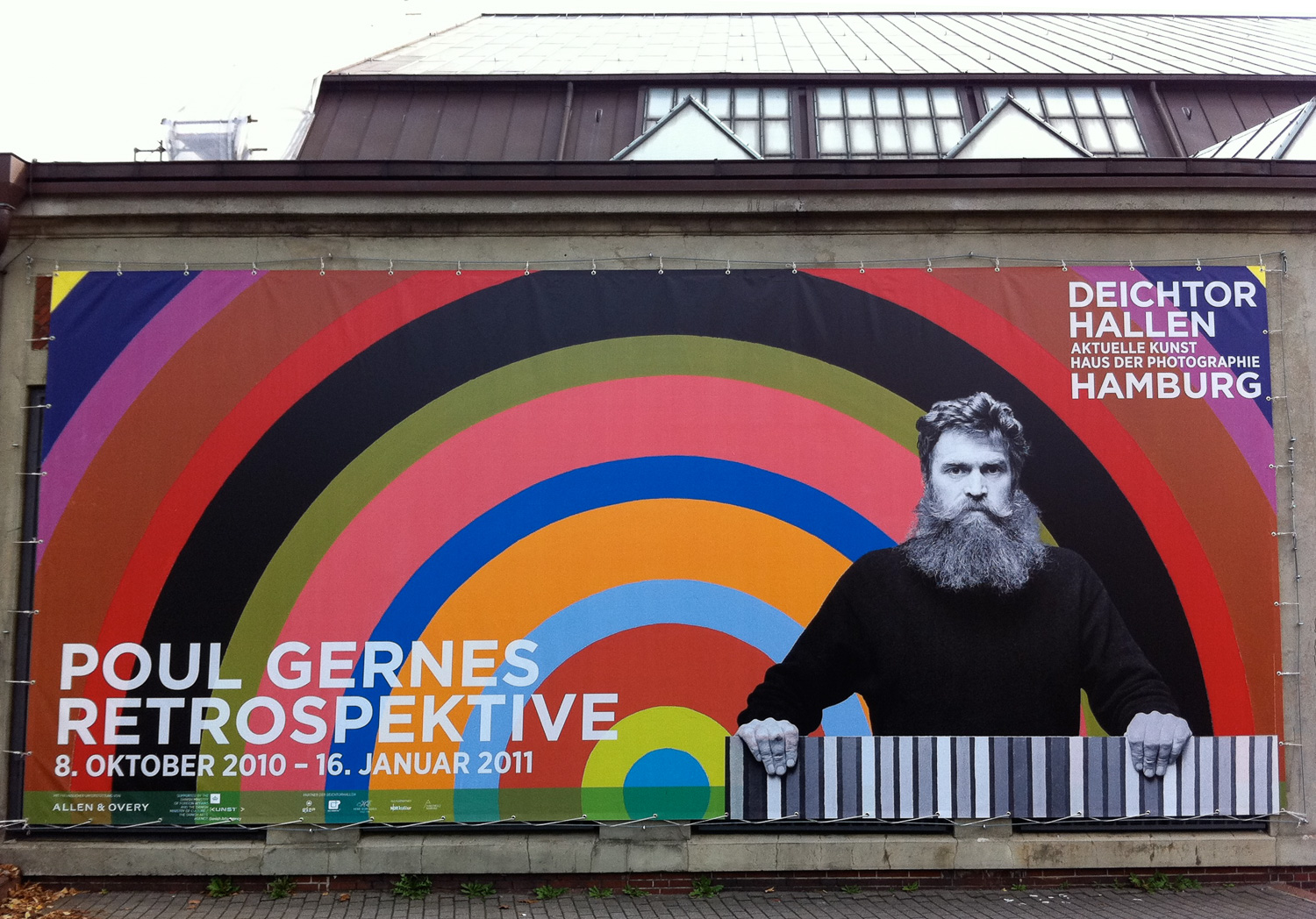
Photo: Ulrikka Gernes
Several examples illustrate how Poul Gernes’ art can be presented:
In the exhibition Colour Me In at Esbjerg Kunstmuseum in 2014, Gernes’ works were integrated with other artworks in a complex, colouristic total experience. [note]Milena Bonifacini and Kæseler Skytte (ed.): Colour Me In. Esbjerg Art Museum 2014.
In the exhibition Flowers for Poul at Galleri Bo Bjerggaard in 2015, a number of contemporary artists presented homage works side by side with pieces by Poul Gernes. [note]Galleri Bo Bjerggaard (ed.): Flowers for Poul. John Armleder, Cosima von Bonin, Paul Fägerskiöld, Callum Innes, SUPERFLEX, Janaina Tschäpe, Erwin Wurm - and Poul Gernes. Copenhagen 2015.
At Himmerlands Kunstmuseum in Aars in 2020, the exhibition Love and Cherries used a decoration at the nearby Vesthimmerland Upper Secondary School as the starting point for exploring Poul Gernes’ ornamental art. [note]Ulrikka S. Gernes & Bibi Saugman Henriksen (ed.): Kærlighed & Kirsebær – Love & Cherries. Poul Gernes in Aars. Frederiksberg 2020.
The book publication Palads by a group of young artists in 2024 is renewing attention to the magnificent decoration of the Palads Cinema in the heart of Copenhagen and deepen our understanding of its significance. [note]Philip Pilekjær, Jacob Birch and Finn Wergel Dahlgren (red.): Palads. Copenhagen 2024.
The extensive body of work still holds potential for shedding light on various aspects of Gernes’ life and practice, not least the impact of his oeuvre on contemporary art. As the dynamic artist and gallerist Ben Kaufmann once expressed in an opening speech for an exhibition: Gernes belongs to the future. [note]Galerie Ben Kaufmann (ed.) Poul Gernes Continued. Berlin 2007.
Translation by Klara Karolines Fond
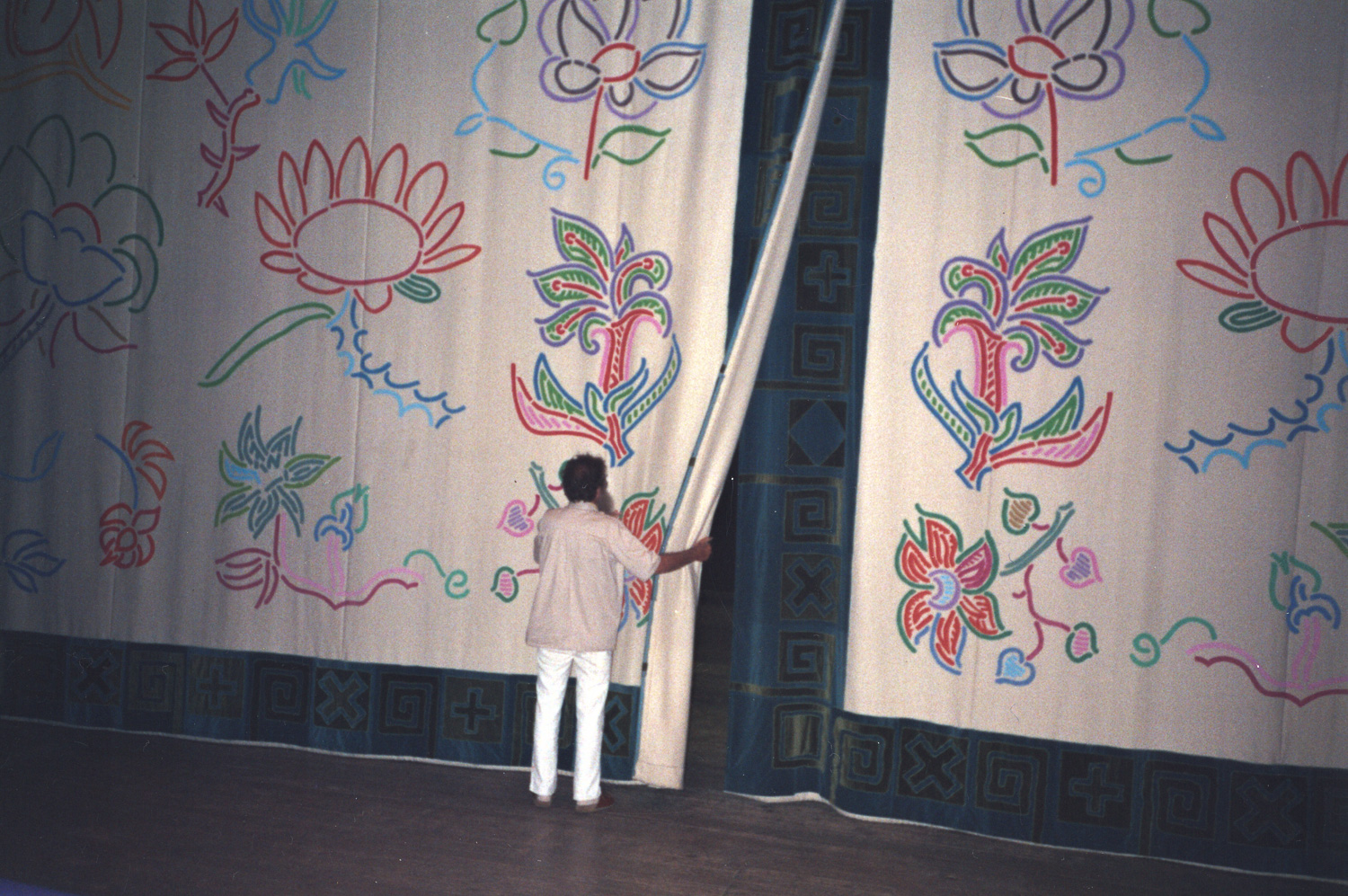
In front of the stage curtain in Morsø Theatre, 1990
Photo: Aase Seidler Gernes